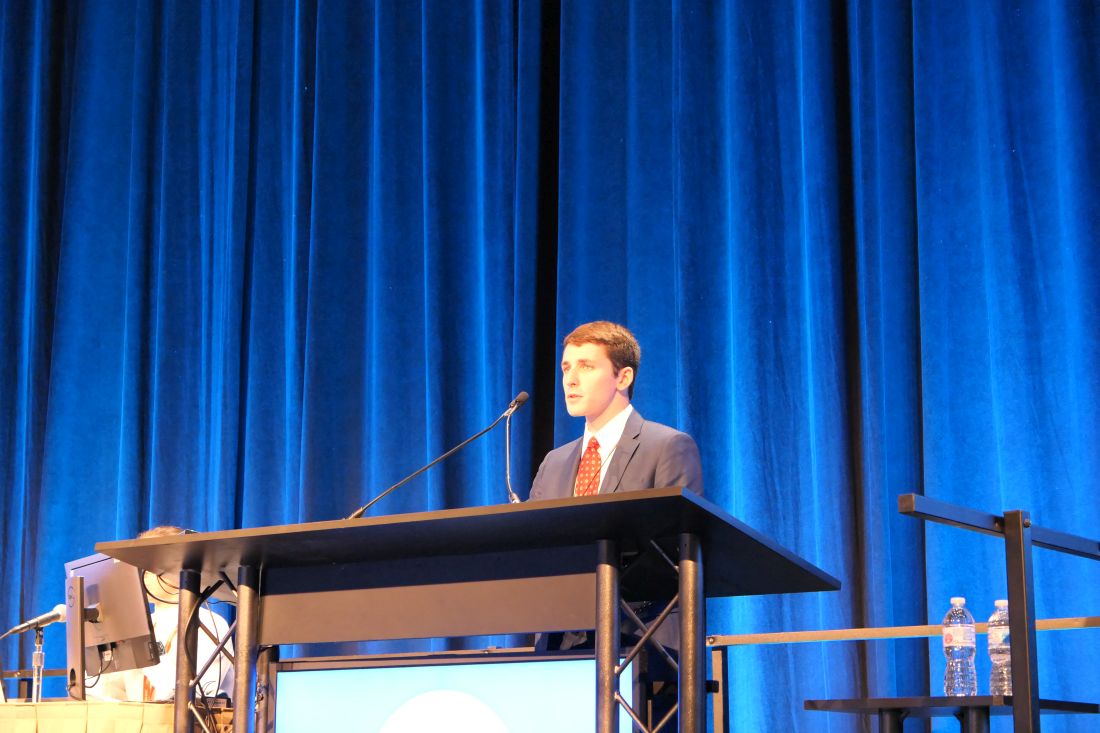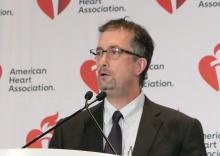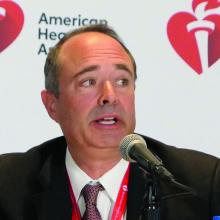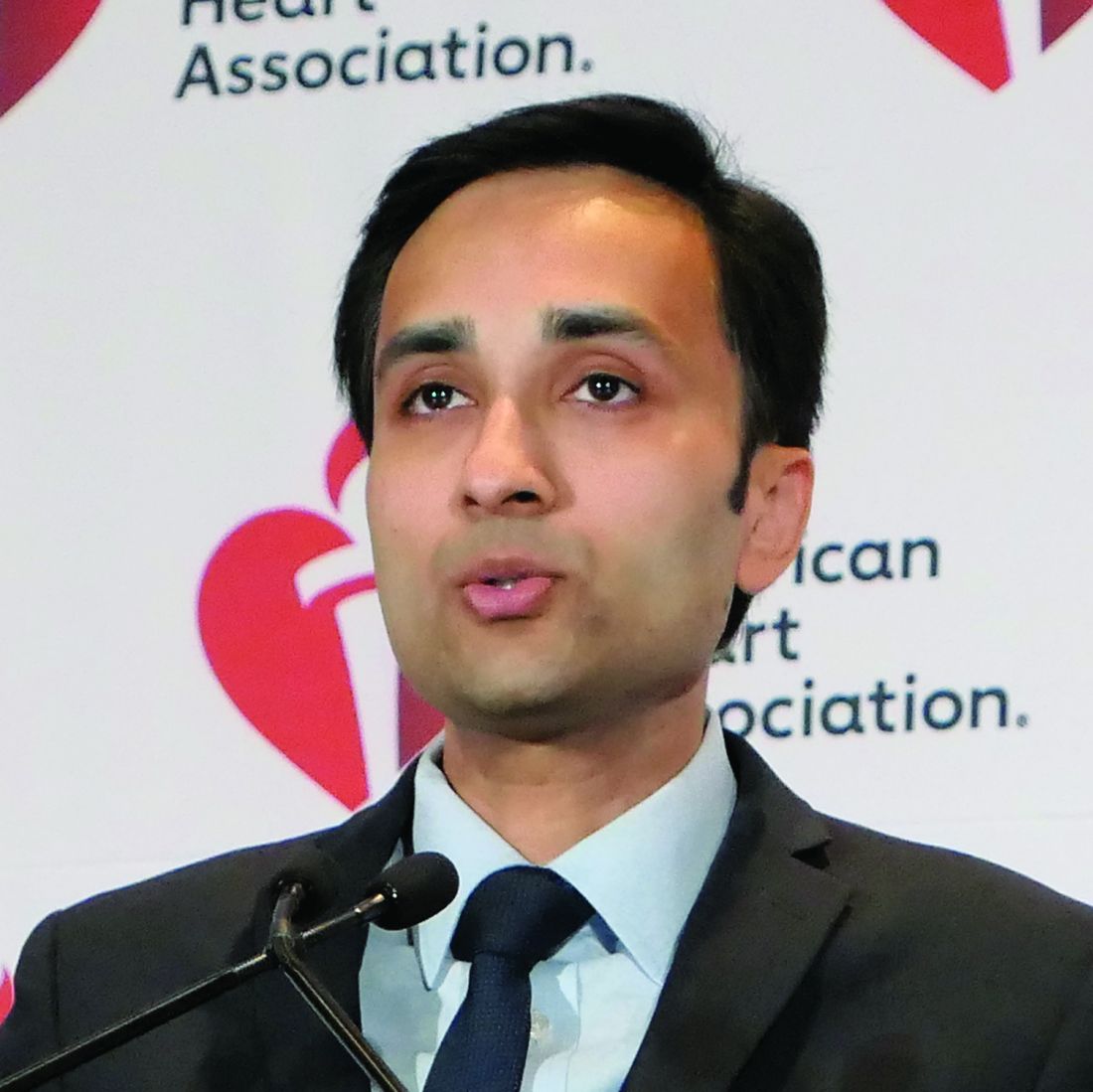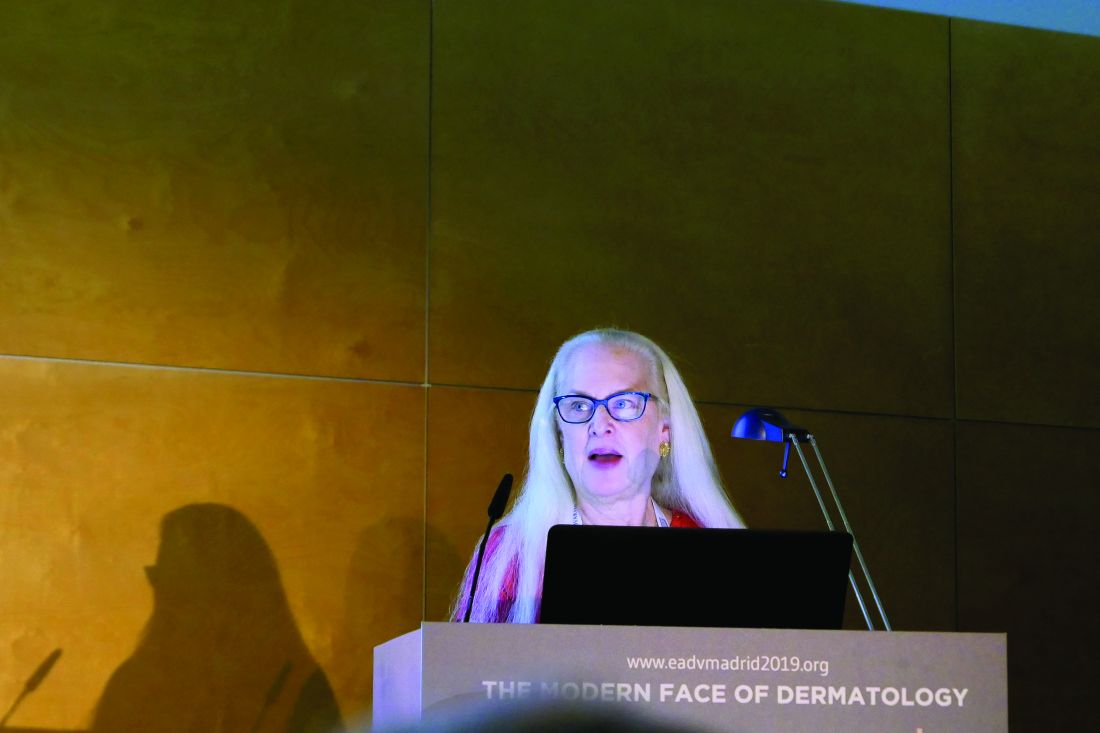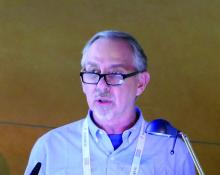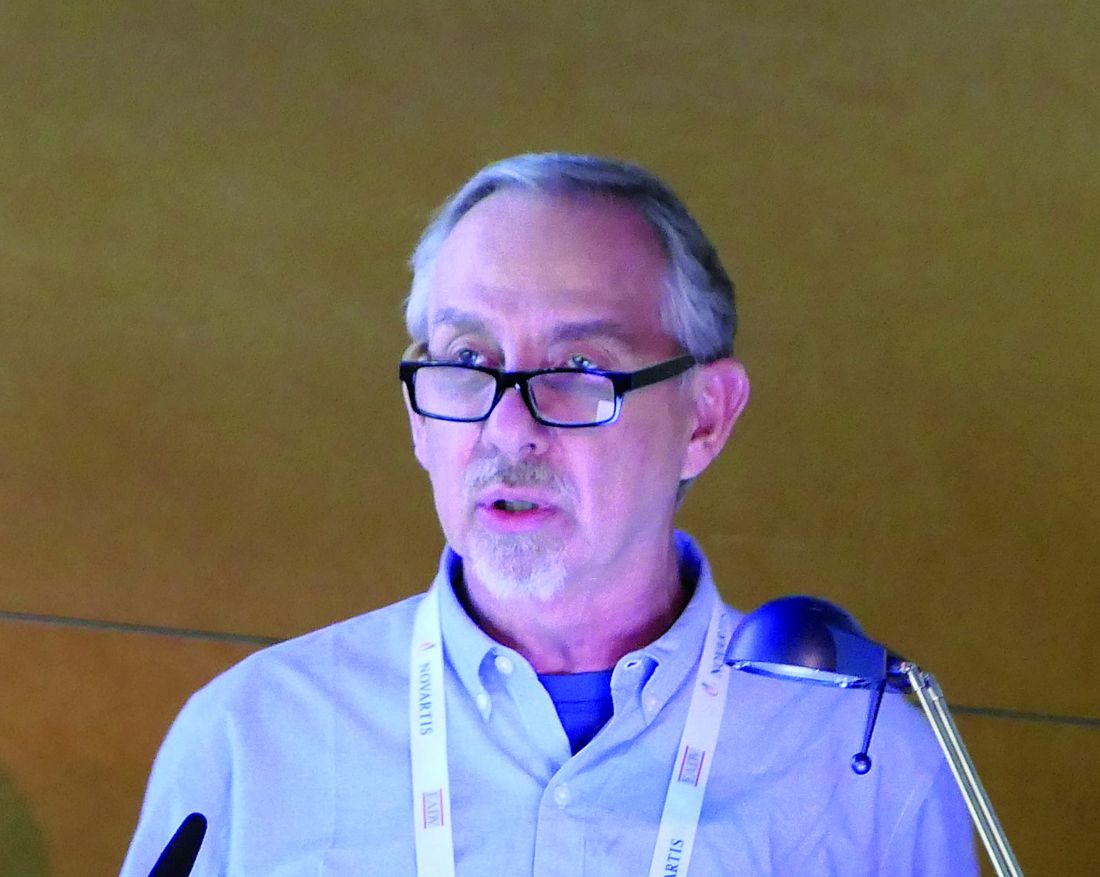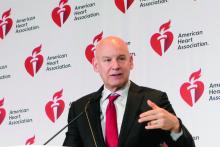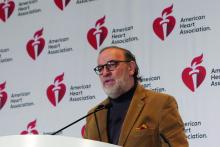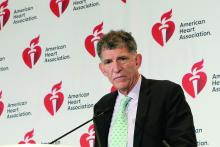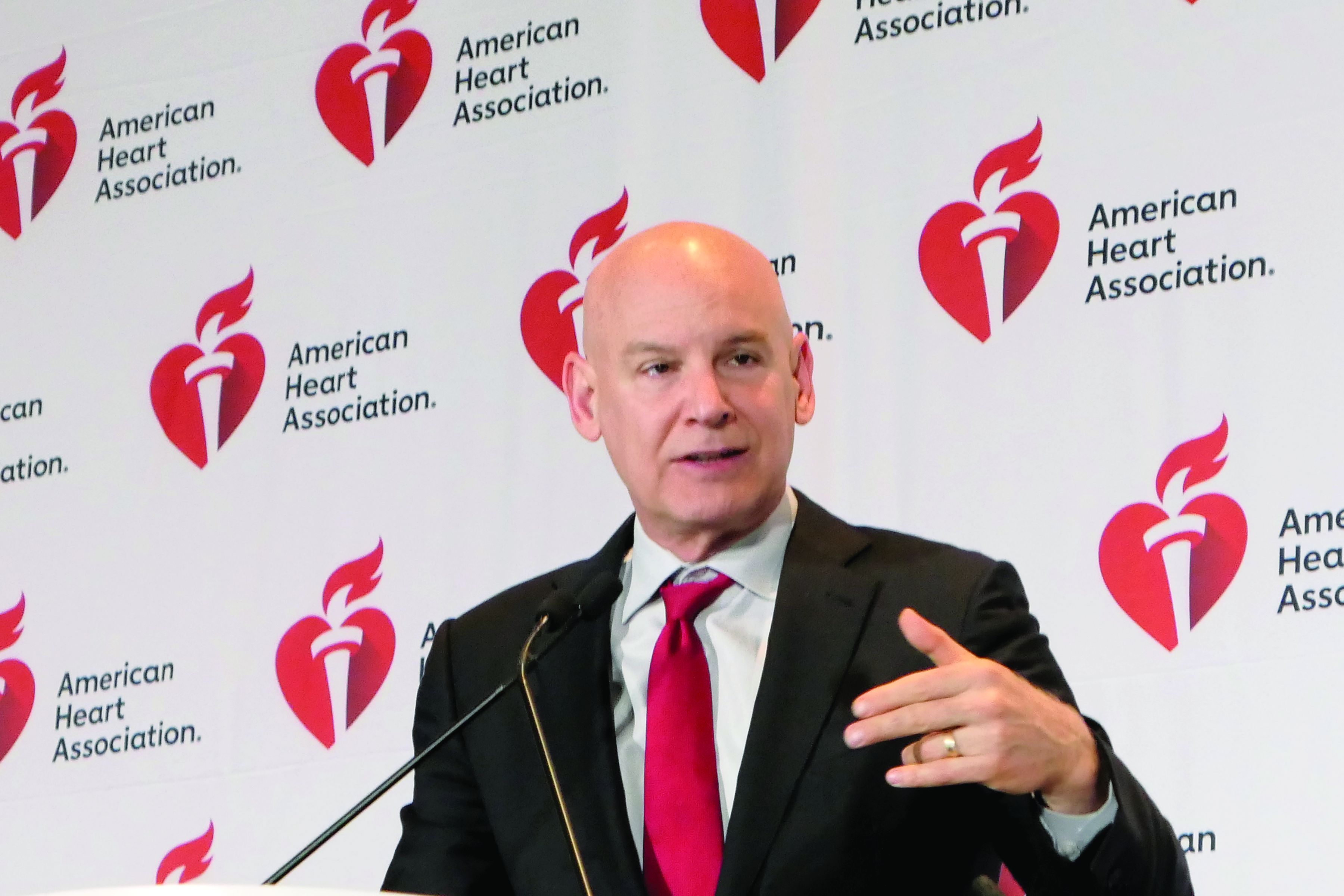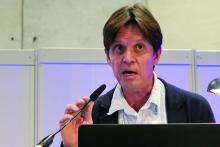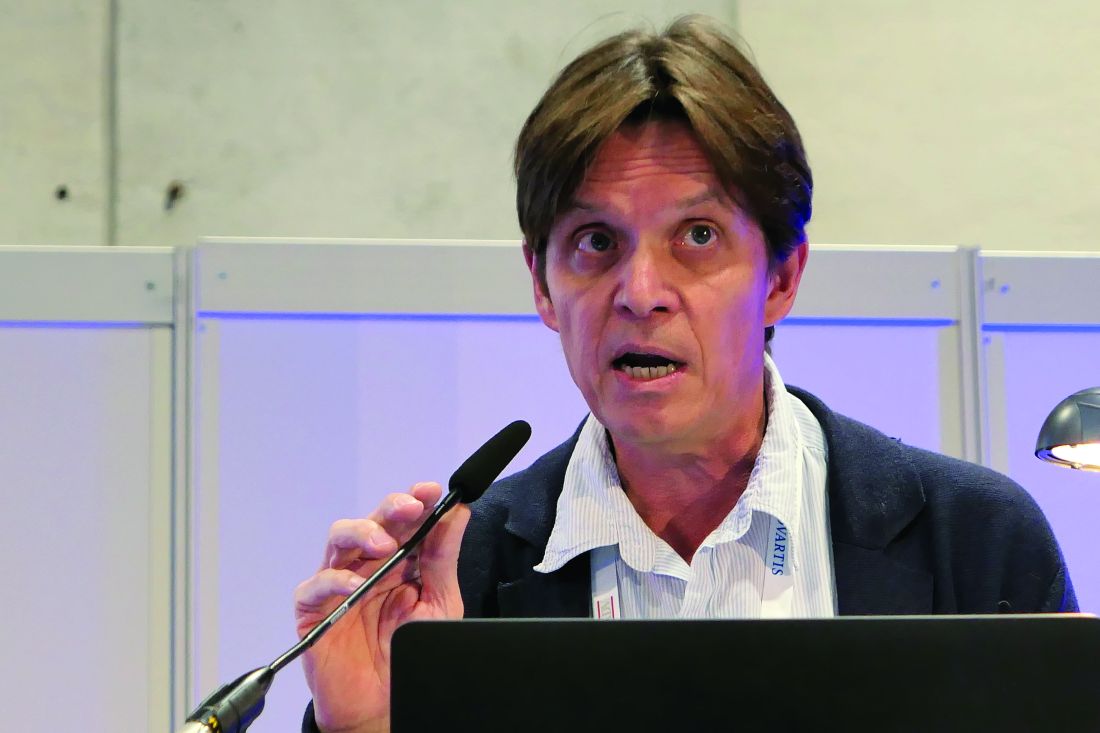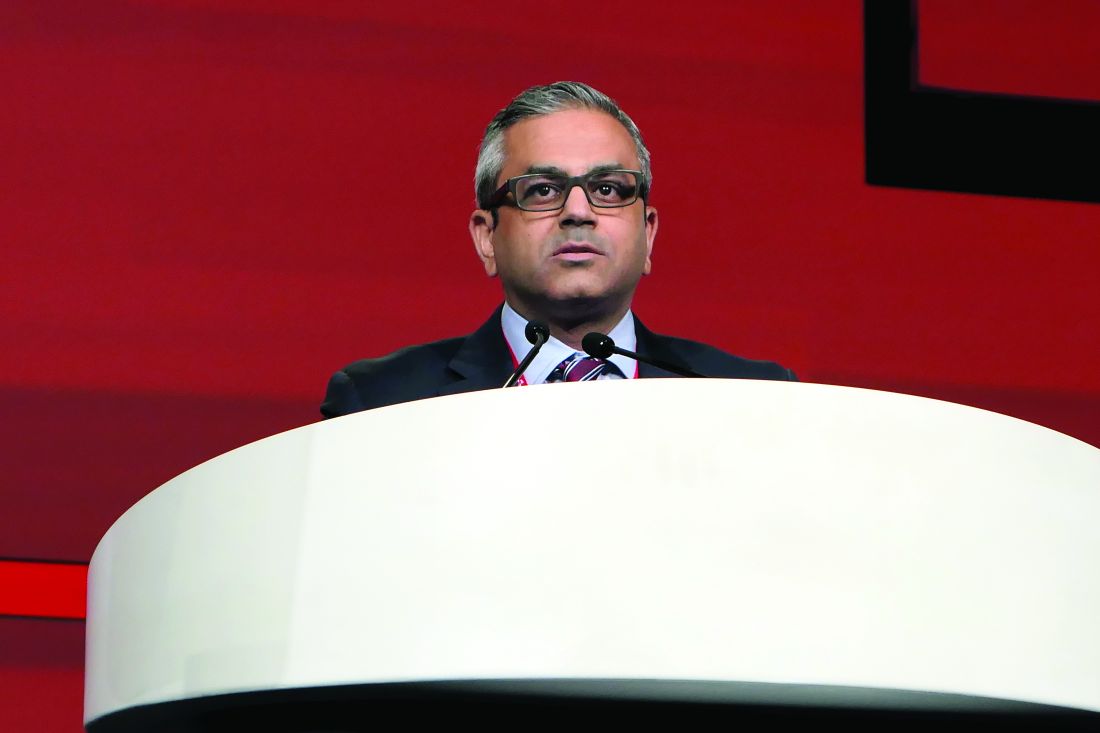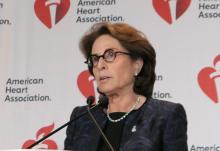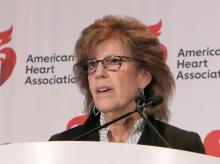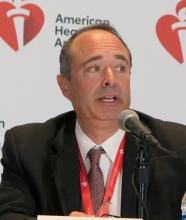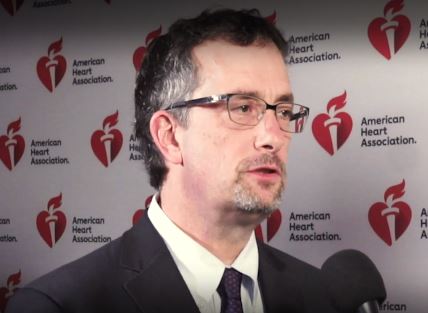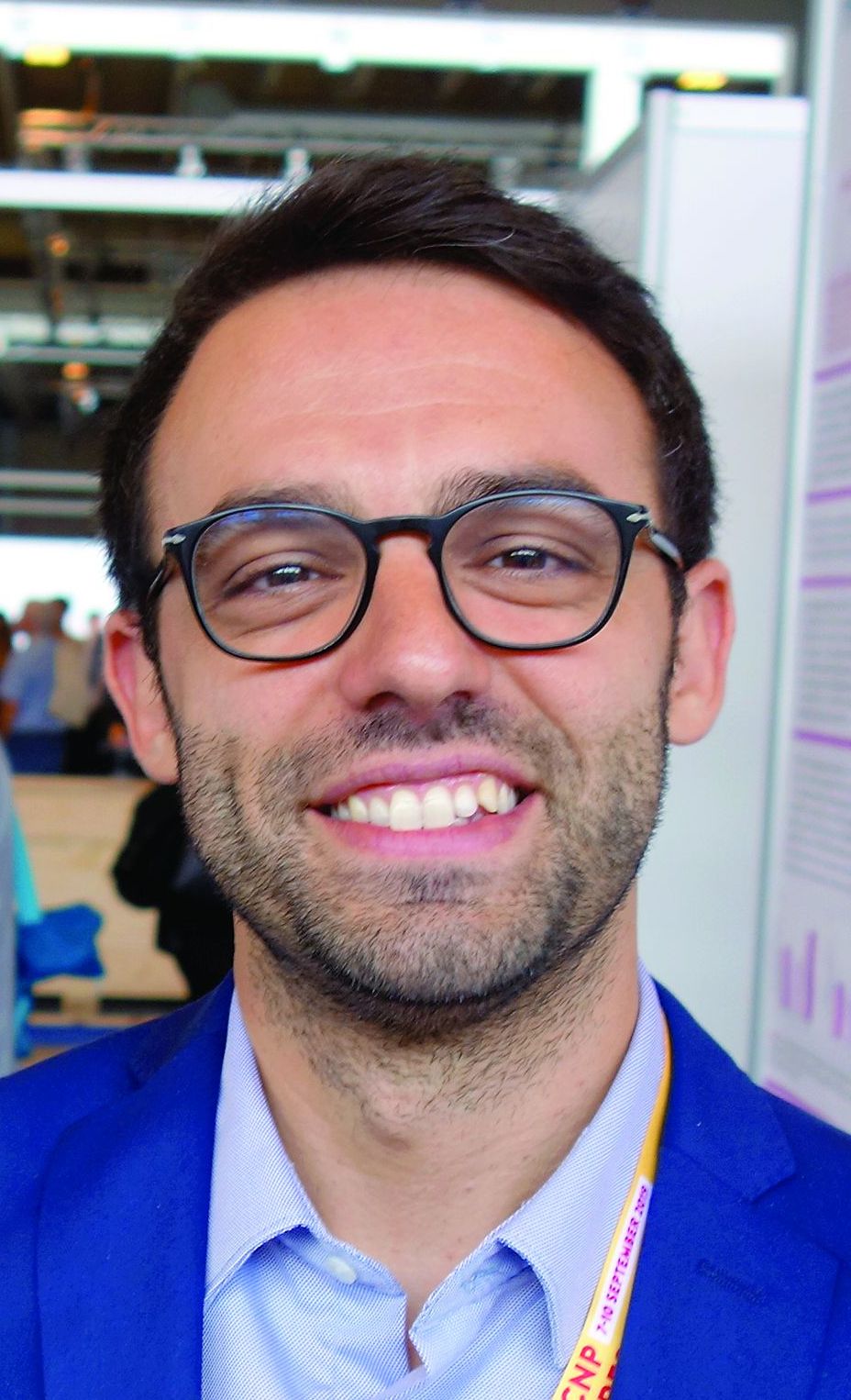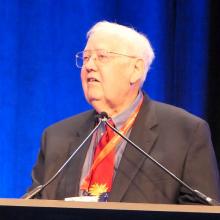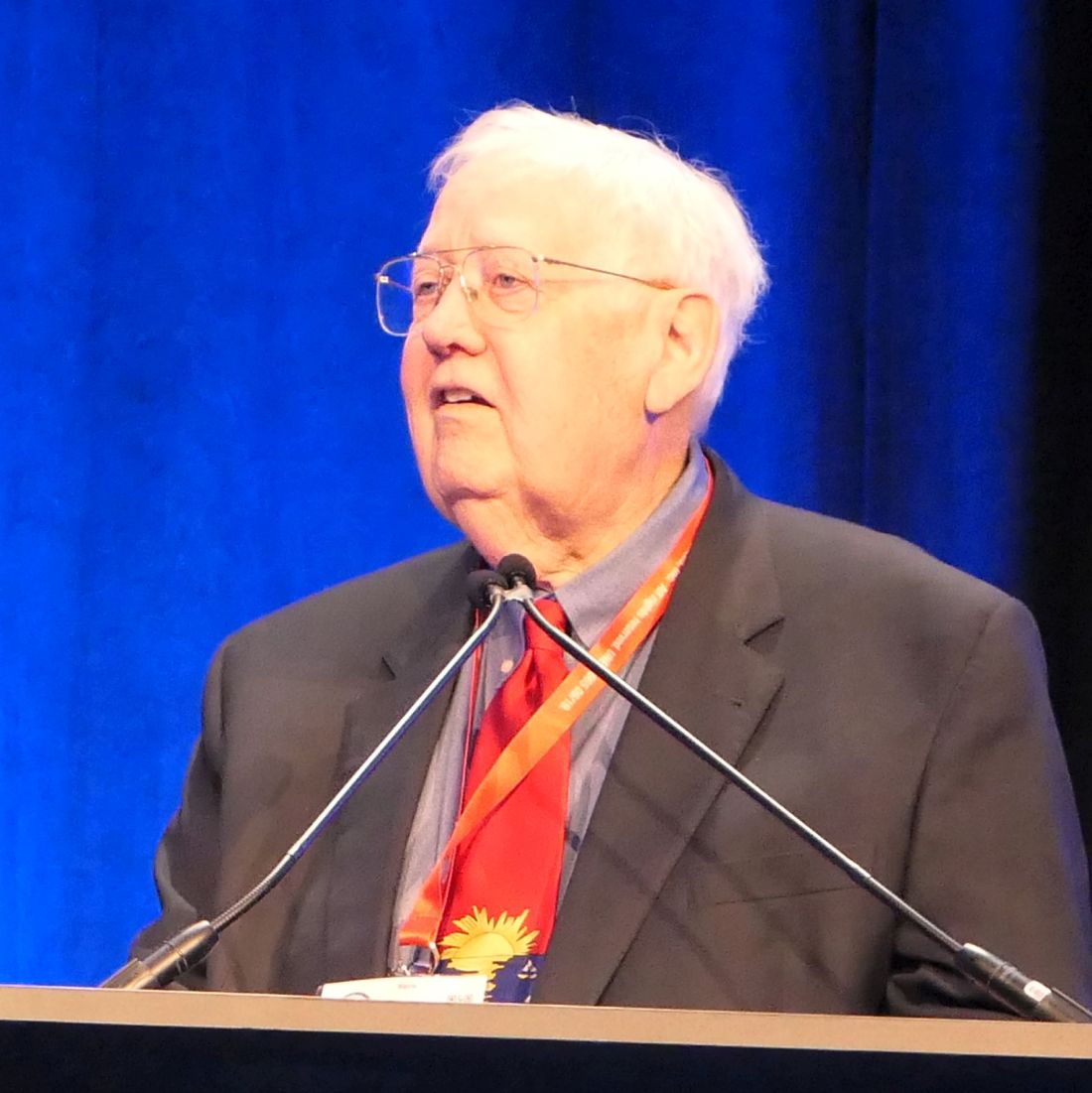User login
Geriatric IBD hospitalization carries steep inpatient mortality
SAN ANTONIO – Jeffrey Schwartz, MD, reported at the annual meeting of the American College of Gastroenterology.
The magnitude of the age-related increased risk highlighted in this large national study was strikingly larger than the differential inpatient mortality between geriatric and nongeriatric patients hospitalized for conditions other than inflammatory bowel disease (IBD). It’s a finding that reveals a major unmet need for improved systems of care for elderly hospitalized IBD patients, according to Dr. Schwartz, an internal medicine resident at Beth Israel Deaconess Medical Center, Boston.
“Given the high prevalence of IBD patients that require inpatient admission, as well as the rapidly aging nature of the U.S. population, it’s our hope that this study will provide some insight to drive efforts to improve standardized guideline-directed therapy and propose interventions to help close what I think is a very important gap in clinical care,” he said.
It’s well established that a second peak of IBD diagnoses occurs in 50- to 70-year-olds. At present, roughly 30% of all individuals carrying the diagnosis of IBD are over age 65, and with the graying of the baby-boomer population, this proportion is climbing.
Dr. Schwartz presented a study of the National Inpatient Sample for 2016, which is a representative sample comprising 20% of all U.S. hospital discharges for that year, the most recent year for which the data are available. The study population included all 71,040 patients hospitalized for acute management of Crohn’s disease or its immediate complications, of whom 10,095 were aged over age 75 years, as well as the 35,950 patients hospitalized for ulcerative colitis, 8,285 of whom were over 75.
Inpatient mortality occurred in 1.5% of the geriatric admissions, compared with 0.2% of nongeriatric admissions for Crohn’s disease. Similarly, the inpatient mortality rate in geriatric patients with ulcerative colitis was 1.0% versus 0.1% in patients under age 75 hospitalized for ulcerative colitis.
There are lots of reasons why the management of geriatric patients with IBD is particularly challenging, Dr. Schwartz noted. They have a higher burden of comorbid conditions, worse nutritional status, and increased risks of infection and cancer. In a regression analysis that attempted to control for such confounders using the Elixhauser mortality index, the nongeriatric Crohn’s disease patients were an adjusted 75% less likely to die in the hospital than those who were older. Nongeriatric ulcerative colitis patients were 81% less likely to die than geriatric patients with the disease. In contrast, nongeriatric patients admitted for reasons other than IBD had only an adjusted 50% lower risk of inpatient mortality than those who were older than 75.
Of note, in this analysis adjusted for confounders, there was no difference between geriatric and nongeriatric IBD patients in terms of resource utilization as reflected in average length of stay and hospital charges, Dr. Schwartz continued.
Asked if he could shed light on any specific complications that drove the age-related disparity in inpatient mortality in the IBD population, the physician replied that he and his coinvestigators were thwarted in their effort to do so because the inpatient mortality of 1.0%-1.5% was so low that further breakdown as to causes of death would have been statistically unreliable. It might be possible to do so successfully by combining several years of National Inpatient Sample data. That being said, it’s reasonable to hypothesize that cardiovascular complications are an important contributor, he added.
Dr. Schwartz reported having no financial conflicts regarding his study, conducted free of commercial support.
SAN ANTONIO – Jeffrey Schwartz, MD, reported at the annual meeting of the American College of Gastroenterology.
The magnitude of the age-related increased risk highlighted in this large national study was strikingly larger than the differential inpatient mortality between geriatric and nongeriatric patients hospitalized for conditions other than inflammatory bowel disease (IBD). It’s a finding that reveals a major unmet need for improved systems of care for elderly hospitalized IBD patients, according to Dr. Schwartz, an internal medicine resident at Beth Israel Deaconess Medical Center, Boston.
“Given the high prevalence of IBD patients that require inpatient admission, as well as the rapidly aging nature of the U.S. population, it’s our hope that this study will provide some insight to drive efforts to improve standardized guideline-directed therapy and propose interventions to help close what I think is a very important gap in clinical care,” he said.
It’s well established that a second peak of IBD diagnoses occurs in 50- to 70-year-olds. At present, roughly 30% of all individuals carrying the diagnosis of IBD are over age 65, and with the graying of the baby-boomer population, this proportion is climbing.
Dr. Schwartz presented a study of the National Inpatient Sample for 2016, which is a representative sample comprising 20% of all U.S. hospital discharges for that year, the most recent year for which the data are available. The study population included all 71,040 patients hospitalized for acute management of Crohn’s disease or its immediate complications, of whom 10,095 were aged over age 75 years, as well as the 35,950 patients hospitalized for ulcerative colitis, 8,285 of whom were over 75.
Inpatient mortality occurred in 1.5% of the geriatric admissions, compared with 0.2% of nongeriatric admissions for Crohn’s disease. Similarly, the inpatient mortality rate in geriatric patients with ulcerative colitis was 1.0% versus 0.1% in patients under age 75 hospitalized for ulcerative colitis.
There are lots of reasons why the management of geriatric patients with IBD is particularly challenging, Dr. Schwartz noted. They have a higher burden of comorbid conditions, worse nutritional status, and increased risks of infection and cancer. In a regression analysis that attempted to control for such confounders using the Elixhauser mortality index, the nongeriatric Crohn’s disease patients were an adjusted 75% less likely to die in the hospital than those who were older. Nongeriatric ulcerative colitis patients were 81% less likely to die than geriatric patients with the disease. In contrast, nongeriatric patients admitted for reasons other than IBD had only an adjusted 50% lower risk of inpatient mortality than those who were older than 75.
Of note, in this analysis adjusted for confounders, there was no difference between geriatric and nongeriatric IBD patients in terms of resource utilization as reflected in average length of stay and hospital charges, Dr. Schwartz continued.
Asked if he could shed light on any specific complications that drove the age-related disparity in inpatient mortality in the IBD population, the physician replied that he and his coinvestigators were thwarted in their effort to do so because the inpatient mortality of 1.0%-1.5% was so low that further breakdown as to causes of death would have been statistically unreliable. It might be possible to do so successfully by combining several years of National Inpatient Sample data. That being said, it’s reasonable to hypothesize that cardiovascular complications are an important contributor, he added.
Dr. Schwartz reported having no financial conflicts regarding his study, conducted free of commercial support.
SAN ANTONIO – Jeffrey Schwartz, MD, reported at the annual meeting of the American College of Gastroenterology.
The magnitude of the age-related increased risk highlighted in this large national study was strikingly larger than the differential inpatient mortality between geriatric and nongeriatric patients hospitalized for conditions other than inflammatory bowel disease (IBD). It’s a finding that reveals a major unmet need for improved systems of care for elderly hospitalized IBD patients, according to Dr. Schwartz, an internal medicine resident at Beth Israel Deaconess Medical Center, Boston.
“Given the high prevalence of IBD patients that require inpatient admission, as well as the rapidly aging nature of the U.S. population, it’s our hope that this study will provide some insight to drive efforts to improve standardized guideline-directed therapy and propose interventions to help close what I think is a very important gap in clinical care,” he said.
It’s well established that a second peak of IBD diagnoses occurs in 50- to 70-year-olds. At present, roughly 30% of all individuals carrying the diagnosis of IBD are over age 65, and with the graying of the baby-boomer population, this proportion is climbing.
Dr. Schwartz presented a study of the National Inpatient Sample for 2016, which is a representative sample comprising 20% of all U.S. hospital discharges for that year, the most recent year for which the data are available. The study population included all 71,040 patients hospitalized for acute management of Crohn’s disease or its immediate complications, of whom 10,095 were aged over age 75 years, as well as the 35,950 patients hospitalized for ulcerative colitis, 8,285 of whom were over 75.
Inpatient mortality occurred in 1.5% of the geriatric admissions, compared with 0.2% of nongeriatric admissions for Crohn’s disease. Similarly, the inpatient mortality rate in geriatric patients with ulcerative colitis was 1.0% versus 0.1% in patients under age 75 hospitalized for ulcerative colitis.
There are lots of reasons why the management of geriatric patients with IBD is particularly challenging, Dr. Schwartz noted. They have a higher burden of comorbid conditions, worse nutritional status, and increased risks of infection and cancer. In a regression analysis that attempted to control for such confounders using the Elixhauser mortality index, the nongeriatric Crohn’s disease patients were an adjusted 75% less likely to die in the hospital than those who were older. Nongeriatric ulcerative colitis patients were 81% less likely to die than geriatric patients with the disease. In contrast, nongeriatric patients admitted for reasons other than IBD had only an adjusted 50% lower risk of inpatient mortality than those who were older than 75.
Of note, in this analysis adjusted for confounders, there was no difference between geriatric and nongeriatric IBD patients in terms of resource utilization as reflected in average length of stay and hospital charges, Dr. Schwartz continued.
Asked if he could shed light on any specific complications that drove the age-related disparity in inpatient mortality in the IBD population, the physician replied that he and his coinvestigators were thwarted in their effort to do so because the inpatient mortality of 1.0%-1.5% was so low that further breakdown as to causes of death would have been statistically unreliable. It might be possible to do so successfully by combining several years of National Inpatient Sample data. That being said, it’s reasonable to hypothesize that cardiovascular complications are an important contributor, he added.
Dr. Schwartz reported having no financial conflicts regarding his study, conducted free of commercial support.
REPORTING FROM ACG 2019
Key clinical point: A major unmet need exists for better guideline-directed management of geriatric patients hospitalized for inflammatory bowel disease.
Major finding: The inpatient mortality rate among patients aged over age 75 years hospitalized for management of inflammatory bowel disease is four to five times higher than in those who are younger.
Study details: This was a retrospective analysis of all 106,990 hospital admissions for management of inflammatory bowel disease included in the 2016 National Inpatient Sample.
Disclosures: The presenter reported having no financial conflicts regarding his study, conducted free of commercial support.
Source: Schwartz J. ACG 2019, Abstract 42.
ISCHEMIA-CKD: No benefit for coronary revascularization in advanced CKD with stable angina
PHILADELPHIA – Coronary revascularization in patients with stage 4 or 5 chronic kidney disease (CKD) and stable ischemic heart disease accomplishes nothing constructive, according to clear-cut results of the landmark ISCHEMIA-CKD trial.
In this multinational randomized trial including 777 stable patients with advanced CKD and moderate or severe myocardial ischemia on noninvasive testing, an early invasive strategy didn’t reduce the risks of death or ischemic events, didn’t provide any significant improvement in quality of life metrics, and resulted in an increased risk of stroke, Sripal Bangalore, MD, reported at the American Heart Association scientific sessions.
“ said Dr. Bangalore, professor of medicine and director of complex coronary intervention at New York University.
This was easily the largest-ever trial of an invasive versus conservative coronary artery disease management strategy in this challenging population. For example, in the COURAGE trial of optimal medical therapy with or without percutaneous coronary intervention for stable coronary disease (N Engl J Med. 2007 Apr 12;356[15]:1503-16), only 16 of the 2,287 participants had an estimated glomerular filtration rate below 30 mL/min per 1.73 m2.
Of note, the participating study sites received special training aimed at minimizing the risk of acute kidney injury after cardiac catheterization in this at-risk population. The training included utilization of a customized left ventricular end diastolic volume–based hydration protocol, guidance on how to perform percutaneous coronary intervention with little or no contrast material, and encouragement of a heart/kidney team approach involving a cardiologist, nephrologist, and cardiovascular surgeon. This training really paid off, with roughly a 7% incidence of acute kidney injury after catheterization.
“The expected rate in such patients would be 30%-60%,” according to Dr. Bangalore.
The primary endpoint in ISCHEMIA-CKD was the rates of death or MI during 3 years of prospective follow-up. This occurred in 36.7% of patients randomized to optimal medical therapy alone and 36.4% of those randomized to an early invasive strategy. Similarly, the major secondary endpoint, comprising death, MI, and hospitalization for unstable angina, heart failure, or resuscitated cardiac arrest, was also a virtual dead heat, occurring in about 39% of subjects. More than 27% of study participants had died by the 3-year mark regardless of how their coronary disease was managed.
The adjusted risk of stroke was 3.76-fold higher in the invasive strategy group; however, the most strokes were not procedurally related, and the explanation for the significantly increased risk in the invasively managed group remains unknown, the cardiologist said.
John A. Spertus, MD, who led the quality of life assessment in ISCHEMIA-CKD and in the 5,129-patient parent ISCHEMIA (International Study of Comparative Health Effectiveness with Medical and Invasive Approaches), also presented at the AHA scientific sessions. He reported that, unlike in the parent study, there was no hint of a meaningful long-term quality of life benefit for revascularization plus optimal medical therapy, compared with that of optimal medical therapy alone, in ISCHEMIA-CKD.
“We have greater than 93% confidence that there is more of a quality of life effect in patients without advanced CKD than in patients with advanced CKD,” said Dr. Spertus, director of health outcomes research at the Saint Luke’s Mid America Heart Institute and professor of medicine at the University of Missouri, Kansas City.
Discussant Glenn L. Levine, MD, hailed ISCHEMIA-CKD as “a monumental achievement,” an ambitious, well-powered study with essentially no loss of follow-up during up to 4 years. It helps fill an utter void in the AHA/American College of Cardiology guidelines, which to date offer no recommendations at all regarding revascularization in patients with CKD because of a lack of evidence. And he considers ISCHEMIA-CKD to be unequivocally practice changing and guideline changing.
“Based on the results of ISCHEMIA-CKD, I will generally not go searching for ischemia and [coronary artery disease] in most severe and end-stage CKD patients, absent marked or unacceptable angina, and will treat them with medical therapy alone,” declared Dr. Levine, professor of medicine at Baylor College of Medicine and director of the cardiac care unit at the Michael E. DeBakey VA Medical Center, both in Houston.
He offered a few caveats. Excluded from participation in ISCHEMIA-CKD were patients with acute coronary syndrome, significant heart failure, or unacceptable angina despite optimal medical therapy at baseline, so the study results don’t apply to them. Also, the acute kidney injury rate after intervention was eye-catchingly low.
Dr. Bangalore discussed the ISCHEMIA-CKD trial and outcomes in a video interview with Medscape’s Tricia Ward.
“It seems unlikely that all centers routinely do and will exactly follow the very careful measures to limit contrast and minimize contrast nephropathy used in this study,” Dr. Levine commented.
ISCHEMIA-CKD, like its parent ISCHEMIA trial, was funded by the National Heart, Lung, and Blood Institute. Dr. Bangalore reported having no relevant financial interests. Dr. Spertus holds the copyright for the Seattle Angina Questionnaire, which was used for quality of life measurement in the trials. Dr. Levine disclosed that he has no relations with industry or conflicts of interest.
PHILADELPHIA – Coronary revascularization in patients with stage 4 or 5 chronic kidney disease (CKD) and stable ischemic heart disease accomplishes nothing constructive, according to clear-cut results of the landmark ISCHEMIA-CKD trial.
In this multinational randomized trial including 777 stable patients with advanced CKD and moderate or severe myocardial ischemia on noninvasive testing, an early invasive strategy didn’t reduce the risks of death or ischemic events, didn’t provide any significant improvement in quality of life metrics, and resulted in an increased risk of stroke, Sripal Bangalore, MD, reported at the American Heart Association scientific sessions.
“ said Dr. Bangalore, professor of medicine and director of complex coronary intervention at New York University.
This was easily the largest-ever trial of an invasive versus conservative coronary artery disease management strategy in this challenging population. For example, in the COURAGE trial of optimal medical therapy with or without percutaneous coronary intervention for stable coronary disease (N Engl J Med. 2007 Apr 12;356[15]:1503-16), only 16 of the 2,287 participants had an estimated glomerular filtration rate below 30 mL/min per 1.73 m2.
Of note, the participating study sites received special training aimed at minimizing the risk of acute kidney injury after cardiac catheterization in this at-risk population. The training included utilization of a customized left ventricular end diastolic volume–based hydration protocol, guidance on how to perform percutaneous coronary intervention with little or no contrast material, and encouragement of a heart/kidney team approach involving a cardiologist, nephrologist, and cardiovascular surgeon. This training really paid off, with roughly a 7% incidence of acute kidney injury after catheterization.
“The expected rate in such patients would be 30%-60%,” according to Dr. Bangalore.
The primary endpoint in ISCHEMIA-CKD was the rates of death or MI during 3 years of prospective follow-up. This occurred in 36.7% of patients randomized to optimal medical therapy alone and 36.4% of those randomized to an early invasive strategy. Similarly, the major secondary endpoint, comprising death, MI, and hospitalization for unstable angina, heart failure, or resuscitated cardiac arrest, was also a virtual dead heat, occurring in about 39% of subjects. More than 27% of study participants had died by the 3-year mark regardless of how their coronary disease was managed.
The adjusted risk of stroke was 3.76-fold higher in the invasive strategy group; however, the most strokes were not procedurally related, and the explanation for the significantly increased risk in the invasively managed group remains unknown, the cardiologist said.
John A. Spertus, MD, who led the quality of life assessment in ISCHEMIA-CKD and in the 5,129-patient parent ISCHEMIA (International Study of Comparative Health Effectiveness with Medical and Invasive Approaches), also presented at the AHA scientific sessions. He reported that, unlike in the parent study, there was no hint of a meaningful long-term quality of life benefit for revascularization plus optimal medical therapy, compared with that of optimal medical therapy alone, in ISCHEMIA-CKD.
“We have greater than 93% confidence that there is more of a quality of life effect in patients without advanced CKD than in patients with advanced CKD,” said Dr. Spertus, director of health outcomes research at the Saint Luke’s Mid America Heart Institute and professor of medicine at the University of Missouri, Kansas City.
Discussant Glenn L. Levine, MD, hailed ISCHEMIA-CKD as “a monumental achievement,” an ambitious, well-powered study with essentially no loss of follow-up during up to 4 years. It helps fill an utter void in the AHA/American College of Cardiology guidelines, which to date offer no recommendations at all regarding revascularization in patients with CKD because of a lack of evidence. And he considers ISCHEMIA-CKD to be unequivocally practice changing and guideline changing.
“Based on the results of ISCHEMIA-CKD, I will generally not go searching for ischemia and [coronary artery disease] in most severe and end-stage CKD patients, absent marked or unacceptable angina, and will treat them with medical therapy alone,” declared Dr. Levine, professor of medicine at Baylor College of Medicine and director of the cardiac care unit at the Michael E. DeBakey VA Medical Center, both in Houston.
He offered a few caveats. Excluded from participation in ISCHEMIA-CKD were patients with acute coronary syndrome, significant heart failure, or unacceptable angina despite optimal medical therapy at baseline, so the study results don’t apply to them. Also, the acute kidney injury rate after intervention was eye-catchingly low.
Dr. Bangalore discussed the ISCHEMIA-CKD trial and outcomes in a video interview with Medscape’s Tricia Ward.
“It seems unlikely that all centers routinely do and will exactly follow the very careful measures to limit contrast and minimize contrast nephropathy used in this study,” Dr. Levine commented.
ISCHEMIA-CKD, like its parent ISCHEMIA trial, was funded by the National Heart, Lung, and Blood Institute. Dr. Bangalore reported having no relevant financial interests. Dr. Spertus holds the copyright for the Seattle Angina Questionnaire, which was used for quality of life measurement in the trials. Dr. Levine disclosed that he has no relations with industry or conflicts of interest.
PHILADELPHIA – Coronary revascularization in patients with stage 4 or 5 chronic kidney disease (CKD) and stable ischemic heart disease accomplishes nothing constructive, according to clear-cut results of the landmark ISCHEMIA-CKD trial.
In this multinational randomized trial including 777 stable patients with advanced CKD and moderate or severe myocardial ischemia on noninvasive testing, an early invasive strategy didn’t reduce the risks of death or ischemic events, didn’t provide any significant improvement in quality of life metrics, and resulted in an increased risk of stroke, Sripal Bangalore, MD, reported at the American Heart Association scientific sessions.
“ said Dr. Bangalore, professor of medicine and director of complex coronary intervention at New York University.
This was easily the largest-ever trial of an invasive versus conservative coronary artery disease management strategy in this challenging population. For example, in the COURAGE trial of optimal medical therapy with or without percutaneous coronary intervention for stable coronary disease (N Engl J Med. 2007 Apr 12;356[15]:1503-16), only 16 of the 2,287 participants had an estimated glomerular filtration rate below 30 mL/min per 1.73 m2.
Of note, the participating study sites received special training aimed at minimizing the risk of acute kidney injury after cardiac catheterization in this at-risk population. The training included utilization of a customized left ventricular end diastolic volume–based hydration protocol, guidance on how to perform percutaneous coronary intervention with little or no contrast material, and encouragement of a heart/kidney team approach involving a cardiologist, nephrologist, and cardiovascular surgeon. This training really paid off, with roughly a 7% incidence of acute kidney injury after catheterization.
“The expected rate in such patients would be 30%-60%,” according to Dr. Bangalore.
The primary endpoint in ISCHEMIA-CKD was the rates of death or MI during 3 years of prospective follow-up. This occurred in 36.7% of patients randomized to optimal medical therapy alone and 36.4% of those randomized to an early invasive strategy. Similarly, the major secondary endpoint, comprising death, MI, and hospitalization for unstable angina, heart failure, or resuscitated cardiac arrest, was also a virtual dead heat, occurring in about 39% of subjects. More than 27% of study participants had died by the 3-year mark regardless of how their coronary disease was managed.
The adjusted risk of stroke was 3.76-fold higher in the invasive strategy group; however, the most strokes were not procedurally related, and the explanation for the significantly increased risk in the invasively managed group remains unknown, the cardiologist said.
John A. Spertus, MD, who led the quality of life assessment in ISCHEMIA-CKD and in the 5,129-patient parent ISCHEMIA (International Study of Comparative Health Effectiveness with Medical and Invasive Approaches), also presented at the AHA scientific sessions. He reported that, unlike in the parent study, there was no hint of a meaningful long-term quality of life benefit for revascularization plus optimal medical therapy, compared with that of optimal medical therapy alone, in ISCHEMIA-CKD.
“We have greater than 93% confidence that there is more of a quality of life effect in patients without advanced CKD than in patients with advanced CKD,” said Dr. Spertus, director of health outcomes research at the Saint Luke’s Mid America Heart Institute and professor of medicine at the University of Missouri, Kansas City.
Discussant Glenn L. Levine, MD, hailed ISCHEMIA-CKD as “a monumental achievement,” an ambitious, well-powered study with essentially no loss of follow-up during up to 4 years. It helps fill an utter void in the AHA/American College of Cardiology guidelines, which to date offer no recommendations at all regarding revascularization in patients with CKD because of a lack of evidence. And he considers ISCHEMIA-CKD to be unequivocally practice changing and guideline changing.
“Based on the results of ISCHEMIA-CKD, I will generally not go searching for ischemia and [coronary artery disease] in most severe and end-stage CKD patients, absent marked or unacceptable angina, and will treat them with medical therapy alone,” declared Dr. Levine, professor of medicine at Baylor College of Medicine and director of the cardiac care unit at the Michael E. DeBakey VA Medical Center, both in Houston.
He offered a few caveats. Excluded from participation in ISCHEMIA-CKD were patients with acute coronary syndrome, significant heart failure, or unacceptable angina despite optimal medical therapy at baseline, so the study results don’t apply to them. Also, the acute kidney injury rate after intervention was eye-catchingly low.
Dr. Bangalore discussed the ISCHEMIA-CKD trial and outcomes in a video interview with Medscape’s Tricia Ward.
“It seems unlikely that all centers routinely do and will exactly follow the very careful measures to limit contrast and minimize contrast nephropathy used in this study,” Dr. Levine commented.
ISCHEMIA-CKD, like its parent ISCHEMIA trial, was funded by the National Heart, Lung, and Blood Institute. Dr. Bangalore reported having no relevant financial interests. Dr. Spertus holds the copyright for the Seattle Angina Questionnaire, which was used for quality of life measurement in the trials. Dr. Levine disclosed that he has no relations with industry or conflicts of interest.
REPORTING FROM AHA 2019
IL-1 alpha is a new target in atopic dermatitis
MADRID – on the basis of an encouraging phase 2, proof-of-concept study involving bermekimab, an investigational monoclonal antibody directed at that cytokine.
The mechanism of benefit is unclear, although there are a number of plausible possibilities, all orbiting around the notion that AD is not only a Th2 immunity–mediated disease, but that Th1 immunity plays a role, too.
“The ultimate proof, as you will see, is that it works,” Alice B. Gottlieb, MD, PhD, observed in presenting the phase 2 study findings at the annual congress of the European Academy of Dermatology and Venereology.
Bermekimab is a monoclonal antibody cloned from human peripheral B lymphocytes. Sources of its target – IL-1 alpha – that are of therapeutic relevance include neutrophils, keratinocytes, platelets, and monocytes.
The study included 10 adults with moderate to severe AD who received a single subcutaneous injection of 200 mg of bermekimab and 28 who received 400 mg weekly for 8 weeks. Lumping together the various outcome measures employed in the study, the 400-mg dose was three times more effective than the 200-mg dose, a finding explainable by the 240% higher serum levels at 400 mg, according to Dr. Gottlieb, medical director of Mount Sinai Beth Israel Dermatology in the department of dermatology at the Icahn School of Medicine at Mount Sinai, New York.
This was a small, uncontrolled, proof-of-concept study; at this early stage, results painted a favorable picture of efficacy and safety. For example, scores on the Eczema Area and Severity Index dropped by a mean of 65% from baseline at week 4 of bermekimab at 400 mg/week and by 80% at week 8. Scoring Atopic Dermatitis scores dropped by about 55% at week 4 and by nearly 70% at 8 weeks. Scores on the 0-4 Investigator Global Assessment improved by 1.2 points at week 4 and 1.4 points by week 8. Dermatology Life Quality Index scores improved by a mean of 70% by week 8, at which point 61% of patients had a DLQI of 0-1, indicating that AD had no or only a slight impact on quality of life. Scores on the Hospital Anxiety and Depression Scale improved by about 45% at 4 weeks and 65% at 8 weeks.
At baseline, most patients rated their pain as 7 out of 10. By week 8, pain scores had dropped by an average of 80%, and 80% of patients experienced a 4-point drop or greater. Similarly, 80% of patients had at least a 4-point drop in their self-rated worst itch scores on a 0-10 scale. The greatest improvement in both pain and itch scores occurred in the first 4 weeks, after which further improvement continued, albeit at a slower rate.
Adverse events consisted of grade 2 wheezing in two patients, grade 1 nausea in two patients, and a 3% rate of mild injection-site reactions.
An audience member rose to comment: “This is really interesting data, and it goes against everything that we think about atopic dermatitis. But we know from allergic contact dermatitis that IL-1 is a very early signal coming out of keratinocytes. It almost makes you wonder whether that’s not a primary problem in atopic dermatitis that we haven’t realized – that the keratinocytes are under stress because of damage to the skin barrier or other functions, and by alleviating that stress by blocking IL-1, you block the progression into what we previously thought was an Th2-mediated disease, atopic dermatitis.”
“I was thinking that, too – that the keratinocytes could be playing a role in atopic dermatitis through IL-1,” Dr. Gottlieb replied.
She noted that her Mount Sinai colleague Emma Guttman-Yassky, MD, PhD, and coinvestigators have demonstrated that a monoclonal antibody that blocks IL-17C is effective in treating AD, and that IL-17C causes keratinocytes to release proinflammatory IL-1 alpha. High levels of IL-1 alpha have been shown to drive leukocyte recruitment into the skin, promote breakdown of the skin barrier through production of matrix metalloproteinase, stimulate itch by a direct effect on nerves, and cause leaky vascular endothelium.
A phase 2 study of bermekimab for treatment of AD enrolled the first patient in mid-November. In addition, Dr. Gottlieb has led a positive phase 2 study of the monoclonal antibody in patients with hidradenitis suppurativa, with a phase 3 trial in the works.
She reported receiving research funding from and serving as a consultant without personal compensation to XBiotech, which sponsored the AD and hidradenitis suppurativa studies. She has similar financial relationships with numerous pharmaceutical companies developing psoriasis medications.
MADRID – on the basis of an encouraging phase 2, proof-of-concept study involving bermekimab, an investigational monoclonal antibody directed at that cytokine.
The mechanism of benefit is unclear, although there are a number of plausible possibilities, all orbiting around the notion that AD is not only a Th2 immunity–mediated disease, but that Th1 immunity plays a role, too.
“The ultimate proof, as you will see, is that it works,” Alice B. Gottlieb, MD, PhD, observed in presenting the phase 2 study findings at the annual congress of the European Academy of Dermatology and Venereology.
Bermekimab is a monoclonal antibody cloned from human peripheral B lymphocytes. Sources of its target – IL-1 alpha – that are of therapeutic relevance include neutrophils, keratinocytes, platelets, and monocytes.
The study included 10 adults with moderate to severe AD who received a single subcutaneous injection of 200 mg of bermekimab and 28 who received 400 mg weekly for 8 weeks. Lumping together the various outcome measures employed in the study, the 400-mg dose was three times more effective than the 200-mg dose, a finding explainable by the 240% higher serum levels at 400 mg, according to Dr. Gottlieb, medical director of Mount Sinai Beth Israel Dermatology in the department of dermatology at the Icahn School of Medicine at Mount Sinai, New York.
This was a small, uncontrolled, proof-of-concept study; at this early stage, results painted a favorable picture of efficacy and safety. For example, scores on the Eczema Area and Severity Index dropped by a mean of 65% from baseline at week 4 of bermekimab at 400 mg/week and by 80% at week 8. Scoring Atopic Dermatitis scores dropped by about 55% at week 4 and by nearly 70% at 8 weeks. Scores on the 0-4 Investigator Global Assessment improved by 1.2 points at week 4 and 1.4 points by week 8. Dermatology Life Quality Index scores improved by a mean of 70% by week 8, at which point 61% of patients had a DLQI of 0-1, indicating that AD had no or only a slight impact on quality of life. Scores on the Hospital Anxiety and Depression Scale improved by about 45% at 4 weeks and 65% at 8 weeks.
At baseline, most patients rated their pain as 7 out of 10. By week 8, pain scores had dropped by an average of 80%, and 80% of patients experienced a 4-point drop or greater. Similarly, 80% of patients had at least a 4-point drop in their self-rated worst itch scores on a 0-10 scale. The greatest improvement in both pain and itch scores occurred in the first 4 weeks, after which further improvement continued, albeit at a slower rate.
Adverse events consisted of grade 2 wheezing in two patients, grade 1 nausea in two patients, and a 3% rate of mild injection-site reactions.
An audience member rose to comment: “This is really interesting data, and it goes against everything that we think about atopic dermatitis. But we know from allergic contact dermatitis that IL-1 is a very early signal coming out of keratinocytes. It almost makes you wonder whether that’s not a primary problem in atopic dermatitis that we haven’t realized – that the keratinocytes are under stress because of damage to the skin barrier or other functions, and by alleviating that stress by blocking IL-1, you block the progression into what we previously thought was an Th2-mediated disease, atopic dermatitis.”
“I was thinking that, too – that the keratinocytes could be playing a role in atopic dermatitis through IL-1,” Dr. Gottlieb replied.
She noted that her Mount Sinai colleague Emma Guttman-Yassky, MD, PhD, and coinvestigators have demonstrated that a monoclonal antibody that blocks IL-17C is effective in treating AD, and that IL-17C causes keratinocytes to release proinflammatory IL-1 alpha. High levels of IL-1 alpha have been shown to drive leukocyte recruitment into the skin, promote breakdown of the skin barrier through production of matrix metalloproteinase, stimulate itch by a direct effect on nerves, and cause leaky vascular endothelium.
A phase 2 study of bermekimab for treatment of AD enrolled the first patient in mid-November. In addition, Dr. Gottlieb has led a positive phase 2 study of the monoclonal antibody in patients with hidradenitis suppurativa, with a phase 3 trial in the works.
She reported receiving research funding from and serving as a consultant without personal compensation to XBiotech, which sponsored the AD and hidradenitis suppurativa studies. She has similar financial relationships with numerous pharmaceutical companies developing psoriasis medications.
MADRID – on the basis of an encouraging phase 2, proof-of-concept study involving bermekimab, an investigational monoclonal antibody directed at that cytokine.
The mechanism of benefit is unclear, although there are a number of plausible possibilities, all orbiting around the notion that AD is not only a Th2 immunity–mediated disease, but that Th1 immunity plays a role, too.
“The ultimate proof, as you will see, is that it works,” Alice B. Gottlieb, MD, PhD, observed in presenting the phase 2 study findings at the annual congress of the European Academy of Dermatology and Venereology.
Bermekimab is a monoclonal antibody cloned from human peripheral B lymphocytes. Sources of its target – IL-1 alpha – that are of therapeutic relevance include neutrophils, keratinocytes, platelets, and monocytes.
The study included 10 adults with moderate to severe AD who received a single subcutaneous injection of 200 mg of bermekimab and 28 who received 400 mg weekly for 8 weeks. Lumping together the various outcome measures employed in the study, the 400-mg dose was three times more effective than the 200-mg dose, a finding explainable by the 240% higher serum levels at 400 mg, according to Dr. Gottlieb, medical director of Mount Sinai Beth Israel Dermatology in the department of dermatology at the Icahn School of Medicine at Mount Sinai, New York.
This was a small, uncontrolled, proof-of-concept study; at this early stage, results painted a favorable picture of efficacy and safety. For example, scores on the Eczema Area and Severity Index dropped by a mean of 65% from baseline at week 4 of bermekimab at 400 mg/week and by 80% at week 8. Scoring Atopic Dermatitis scores dropped by about 55% at week 4 and by nearly 70% at 8 weeks. Scores on the 0-4 Investigator Global Assessment improved by 1.2 points at week 4 and 1.4 points by week 8. Dermatology Life Quality Index scores improved by a mean of 70% by week 8, at which point 61% of patients had a DLQI of 0-1, indicating that AD had no or only a slight impact on quality of life. Scores on the Hospital Anxiety and Depression Scale improved by about 45% at 4 weeks and 65% at 8 weeks.
At baseline, most patients rated their pain as 7 out of 10. By week 8, pain scores had dropped by an average of 80%, and 80% of patients experienced a 4-point drop or greater. Similarly, 80% of patients had at least a 4-point drop in their self-rated worst itch scores on a 0-10 scale. The greatest improvement in both pain and itch scores occurred in the first 4 weeks, after which further improvement continued, albeit at a slower rate.
Adverse events consisted of grade 2 wheezing in two patients, grade 1 nausea in two patients, and a 3% rate of mild injection-site reactions.
An audience member rose to comment: “This is really interesting data, and it goes against everything that we think about atopic dermatitis. But we know from allergic contact dermatitis that IL-1 is a very early signal coming out of keratinocytes. It almost makes you wonder whether that’s not a primary problem in atopic dermatitis that we haven’t realized – that the keratinocytes are under stress because of damage to the skin barrier or other functions, and by alleviating that stress by blocking IL-1, you block the progression into what we previously thought was an Th2-mediated disease, atopic dermatitis.”
“I was thinking that, too – that the keratinocytes could be playing a role in atopic dermatitis through IL-1,” Dr. Gottlieb replied.
She noted that her Mount Sinai colleague Emma Guttman-Yassky, MD, PhD, and coinvestigators have demonstrated that a monoclonal antibody that blocks IL-17C is effective in treating AD, and that IL-17C causes keratinocytes to release proinflammatory IL-1 alpha. High levels of IL-1 alpha have been shown to drive leukocyte recruitment into the skin, promote breakdown of the skin barrier through production of matrix metalloproteinase, stimulate itch by a direct effect on nerves, and cause leaky vascular endothelium.
A phase 2 study of bermekimab for treatment of AD enrolled the first patient in mid-November. In addition, Dr. Gottlieb has led a positive phase 2 study of the monoclonal antibody in patients with hidradenitis suppurativa, with a phase 3 trial in the works.
She reported receiving research funding from and serving as a consultant without personal compensation to XBiotech, which sponsored the AD and hidradenitis suppurativa studies. She has similar financial relationships with numerous pharmaceutical companies developing psoriasis medications.
REPORTING FROM EADV 2019
Satisfaction high among psoriasis patients on apremilast
MADRID – within the next 12 months than were patients on their first tumor necrosis factor (TNF) inhibitor, in a large retrospective national propensity score-matched study.
“This was surprising to us,” David L. Kaplan, MD, admitted in presenting the study findings at the annual congress of the European Academy of Dermatology and Venereology.
The surprise came because apremilast, a phosphodiesterase 4 (PDE4)-inhibitor, is less potent than the injectable biologics at driving down Psoriasis Area and Severity Index (PASI) scores.
“This is real-world data. And this is what patients are saying at 1 year: that they’re actually happier [with apremilast] and they’re not interested in changing,” said Dr. Kaplan, a dermatologist at the University of Kansas and in private practice in Overland Park, Kan.
He and his coinvestigators tapped the IBM Watson MarketScan health insurance claims database for 2015-2016 and identified 1,645 biologic-naive adults with psoriasis who started on apremilast therapy and an equal number of biologic-naive psoriasis patients who initiated treatment with a biologic, of whom 1,207 started on an TNF inhibitor and 438 began on an interleukin inhibitor, which was ustekinumab in 81% of cases. The TNF inhibitor cohort was split 80/20 between adalimumab and etanercept. The three groups – new users of apremilast, a TNF inhibitor, or an interleukin inhibitor – were propensity-matched based upon age, prior usage of systemic psoriasis therapies, Charlson Comorbidity Index scores, and other potential confounders.
The primary endpoint was the switch rate to a different psoriasis treatment within 12 months. The switch rate was significantly lower in patients who had started on apremilast than in those on a TNF inhibitor by a margin of 14% to 25%, while the 11% switch rate among patients on an interleukin inhibitor was not significantly different from the rate in the apremilast group.
“I think this data kind of gives us pause,” the dermatologist said. “As a clinician myself, when patients come back in the first question I always ask is, ‘How’re you doing? Are you happy?’ And at the end of the day, the data in terms of switch rates shows where patients are at. And that doesn’t really follow what we see with PASI scores.”
A secondary endpoint was the switch rate through 24 months. The same pattern held true: 24.9% in the apremilast starters, which was similar to the 22.9% in patients initiated on an interleukin inhibitor, and significantly less than the 39.1% rate in the TNF inhibitor group.
Among patients who switched medications within the first 12 months, the mean number of days to the switch was similar across all three groups.
The study had several limitations. Propensity score–matching is not a cure-all that can eradicate all potential biases. And the claims database didn’t include information on why patients switched, nor what their PASI scores were. “This is real-world data, and clinicians don’t do PASI scores in the real world,” he noted.
Audience member Andrew Blauvelt, MD, a dermatologist and president of the Oregon Medical Research Center, Portland, rose to challenge Dr. Kaplan’s conclusion that patients on apremilast were happier with their care.
“How can you rule out that it’s just practices that don’t use biologics, and they’re keeping patients on apremilast regardless of whether they’re better or happy because they’re not using biologics?” inquired Dr. Blauvelt.
Dr. Kaplan conceded that might well be a partial explanation for the results.
“Reluctance to use biologics is out there,” he agreed.
Dr. Kaplan reported serving as a consultant and paid speaker for Celgene, the study sponsor, as well as several other pharmaceutical companies.
SOURCE: Kaplan DL. EADV Abstract FC04.04.
MADRID – within the next 12 months than were patients on their first tumor necrosis factor (TNF) inhibitor, in a large retrospective national propensity score-matched study.
“This was surprising to us,” David L. Kaplan, MD, admitted in presenting the study findings at the annual congress of the European Academy of Dermatology and Venereology.
The surprise came because apremilast, a phosphodiesterase 4 (PDE4)-inhibitor, is less potent than the injectable biologics at driving down Psoriasis Area and Severity Index (PASI) scores.
“This is real-world data. And this is what patients are saying at 1 year: that they’re actually happier [with apremilast] and they’re not interested in changing,” said Dr. Kaplan, a dermatologist at the University of Kansas and in private practice in Overland Park, Kan.
He and his coinvestigators tapped the IBM Watson MarketScan health insurance claims database for 2015-2016 and identified 1,645 biologic-naive adults with psoriasis who started on apremilast therapy and an equal number of biologic-naive psoriasis patients who initiated treatment with a biologic, of whom 1,207 started on an TNF inhibitor and 438 began on an interleukin inhibitor, which was ustekinumab in 81% of cases. The TNF inhibitor cohort was split 80/20 between adalimumab and etanercept. The three groups – new users of apremilast, a TNF inhibitor, or an interleukin inhibitor – were propensity-matched based upon age, prior usage of systemic psoriasis therapies, Charlson Comorbidity Index scores, and other potential confounders.
The primary endpoint was the switch rate to a different psoriasis treatment within 12 months. The switch rate was significantly lower in patients who had started on apremilast than in those on a TNF inhibitor by a margin of 14% to 25%, while the 11% switch rate among patients on an interleukin inhibitor was not significantly different from the rate in the apremilast group.
“I think this data kind of gives us pause,” the dermatologist said. “As a clinician myself, when patients come back in the first question I always ask is, ‘How’re you doing? Are you happy?’ And at the end of the day, the data in terms of switch rates shows where patients are at. And that doesn’t really follow what we see with PASI scores.”
A secondary endpoint was the switch rate through 24 months. The same pattern held true: 24.9% in the apremilast starters, which was similar to the 22.9% in patients initiated on an interleukin inhibitor, and significantly less than the 39.1% rate in the TNF inhibitor group.
Among patients who switched medications within the first 12 months, the mean number of days to the switch was similar across all three groups.
The study had several limitations. Propensity score–matching is not a cure-all that can eradicate all potential biases. And the claims database didn’t include information on why patients switched, nor what their PASI scores were. “This is real-world data, and clinicians don’t do PASI scores in the real world,” he noted.
Audience member Andrew Blauvelt, MD, a dermatologist and president of the Oregon Medical Research Center, Portland, rose to challenge Dr. Kaplan’s conclusion that patients on apremilast were happier with their care.
“How can you rule out that it’s just practices that don’t use biologics, and they’re keeping patients on apremilast regardless of whether they’re better or happy because they’re not using biologics?” inquired Dr. Blauvelt.
Dr. Kaplan conceded that might well be a partial explanation for the results.
“Reluctance to use biologics is out there,” he agreed.
Dr. Kaplan reported serving as a consultant and paid speaker for Celgene, the study sponsor, as well as several other pharmaceutical companies.
SOURCE: Kaplan DL. EADV Abstract FC04.04.
MADRID – within the next 12 months than were patients on their first tumor necrosis factor (TNF) inhibitor, in a large retrospective national propensity score-matched study.
“This was surprising to us,” David L. Kaplan, MD, admitted in presenting the study findings at the annual congress of the European Academy of Dermatology and Venereology.
The surprise came because apremilast, a phosphodiesterase 4 (PDE4)-inhibitor, is less potent than the injectable biologics at driving down Psoriasis Area and Severity Index (PASI) scores.
“This is real-world data. And this is what patients are saying at 1 year: that they’re actually happier [with apremilast] and they’re not interested in changing,” said Dr. Kaplan, a dermatologist at the University of Kansas and in private practice in Overland Park, Kan.
He and his coinvestigators tapped the IBM Watson MarketScan health insurance claims database for 2015-2016 and identified 1,645 biologic-naive adults with psoriasis who started on apremilast therapy and an equal number of biologic-naive psoriasis patients who initiated treatment with a biologic, of whom 1,207 started on an TNF inhibitor and 438 began on an interleukin inhibitor, which was ustekinumab in 81% of cases. The TNF inhibitor cohort was split 80/20 between adalimumab and etanercept. The three groups – new users of apremilast, a TNF inhibitor, or an interleukin inhibitor – were propensity-matched based upon age, prior usage of systemic psoriasis therapies, Charlson Comorbidity Index scores, and other potential confounders.
The primary endpoint was the switch rate to a different psoriasis treatment within 12 months. The switch rate was significantly lower in patients who had started on apremilast than in those on a TNF inhibitor by a margin of 14% to 25%, while the 11% switch rate among patients on an interleukin inhibitor was not significantly different from the rate in the apremilast group.
“I think this data kind of gives us pause,” the dermatologist said. “As a clinician myself, when patients come back in the first question I always ask is, ‘How’re you doing? Are you happy?’ And at the end of the day, the data in terms of switch rates shows where patients are at. And that doesn’t really follow what we see with PASI scores.”
A secondary endpoint was the switch rate through 24 months. The same pattern held true: 24.9% in the apremilast starters, which was similar to the 22.9% in patients initiated on an interleukin inhibitor, and significantly less than the 39.1% rate in the TNF inhibitor group.
Among patients who switched medications within the first 12 months, the mean number of days to the switch was similar across all three groups.
The study had several limitations. Propensity score–matching is not a cure-all that can eradicate all potential biases. And the claims database didn’t include information on why patients switched, nor what their PASI scores were. “This is real-world data, and clinicians don’t do PASI scores in the real world,” he noted.
Audience member Andrew Blauvelt, MD, a dermatologist and president of the Oregon Medical Research Center, Portland, rose to challenge Dr. Kaplan’s conclusion that patients on apremilast were happier with their care.
“How can you rule out that it’s just practices that don’t use biologics, and they’re keeping patients on apremilast regardless of whether they’re better or happy because they’re not using biologics?” inquired Dr. Blauvelt.
Dr. Kaplan conceded that might well be a partial explanation for the results.
“Reluctance to use biologics is out there,” he agreed.
Dr. Kaplan reported serving as a consultant and paid speaker for Celgene, the study sponsor, as well as several other pharmaceutical companies.
SOURCE: Kaplan DL. EADV Abstract FC04.04.
REPORTING FROM EADV 2019
RNA inhibitors silence two new targets in dyslipidemia
PHILADELPHIA – A novel treatment strategy tackling hypertriglyceridemia via long-acting agents targeting two specific culprit genes caused a stir based on the highly encouraging early results of two small proof-of-concept studies presented at the American Heart Association scientific sessions.
ARO-APOC3 is a small interfering ribonucleic acid molecule (siRNA) targeting the apolipoprotein C-III gene (APOC3) specifically within hepatocytes, while ARO-ANG3 is an siRNA targeting hepatic angiotensinlike protein 3 (ANG3). ARO-APOC3 is being developed as a potential treatment for familial chylomicronemia syndrome, a rare disorder associated with triglyceride levels in excess of 800 mg/dL, as well as for patients with severe hypertriglyceridemia and associated pancreatitis – a far more common condition – and ultimately, perhaps, for patients with hypertriglyceridemia and heart disease. ARO-ANG3, which lowers very-low-density lipoprotein (VLDL) as well as LDL cholesterol while increasing HDL cholesterol levels, is under development as a treatment for high triglycerides, homozygous familial hypercholesterolemia, nonalcoholic fatty liver disease, and metabolic diseases.
Christie M. Ballantyne, MD, presented the results of the phase 1/2a study of ARO-APOC3, which included 40 healthy subjects who received a single subcutaneous injection of the RNA inhibitor at 10, 25, 50, or 100 mg and were followed for 16 weeks. At the highest dose, it reduced serum APOC3 levels by 94%, triglyceride levels by 64%, LDL cholesterol levels by up to 25%, and VLDL by a maximum of 68%, while boosting HDL cholesterol levels by up to 69%. These substantial changes in lipids remained stable through week 16.
The observed prolonged duration of effect provides a potential opportunity for dosing quarterly or perhaps even twice a year. This would be ideal for patients who have problems with adherence to daily therapy with statins and other oral agents, observed Dr. Ballantyne, professor of medicine and professor of molecular and human genetics at Baylor College of Medicine, Houston.
Gerald F. Watts, MBBS, DM, DSc, PhD, presented a separate phase 1/2a, 16-week study of a single dose of ARO-ANG3 at 35, 100, 200, or 300 mg in 40 dyslipidemic subjects who were not on background lipid-lowering therapy. The impact on lipids was similar to that achieved by silencing apolipoprotein C-III, except that the reduction in LDL cholesterol was larger and ARO-ANG3 reduced HDL cholesterol in dose-dependent fashion by up to 26%. As in the ARO-APOC3 study, the safety profile of the ANG3 RNA inhibitor raised no concerns, with no study dropouts and no serious adverse events, added Dr. Watts, professor of medicine at the University of Western Australia, Perth.
Discussant Daniel J. Rader, MD, noted that there is an unmet need for hypertriglyceridemia-lowering therapies, because elevated triglycerides can cause pancreatitis as well as coronary disease.
“These siRNA molecules are catalytic: They can go around and destroy multiple aspects of the target RNAs in a way that provides substantial longevity of effect, which is quite remarkable,” explained Dr. Rader, professor of molecular medicine and director of the preventive cardiology program at the University of Pennsylvania, Philadelphia.
Hypertriglyceridemia is often a challenge to treat successfully in clinical practice, so the siRNA studies drew considerable attention, not only for the impressive size and durability of the lipid changes, but also because of the way in which the target genes were identified, a process that began by genetic analysis of individuals with inherently low levels of APOC3 and ANG3.
“One of the really interesting parts of this story is the rapidity with which we went from target identification to therapeutics, now moving into phase 1 and 2 trials. It’s happening much more rapidly than we’ve ever seen before,” commented AHA scientific sessions program chair Donald Lloyd-Jones, MD, senior associate dean for clinical and translational research and chair of the department of preventive medicine at Northwestern University, Chicago.
Still, he was quick to inject a cautionary note. “These genomic studies can show us that having lower levels of these proteins is associated with lower risk. But that doesn’t necessarily mean that lowering levels of these proteins will lower risk, and it certainly doesn’t tell us anything about potential safety concerns.”
In an interview, AHA spokesperson Jennifer Robinson, MD, made a similar point: “We have had lots of fibrate trials in which we’ve lowered triglycerides, and they didn’t really work.”
Yet she, too, was clearly caught up in the thrill of the early evidence of a novel means of treating new targets in dyslipidemia.
“We’re on the cusp of the genetic revolution,” declared Dr. Robinson, professor of epidemiology and director of the preventive and intervention center at the University of Iowa, Iowa City. “For us science nerds, this is so exciting. It’s so cool. The brilliance of these compounds is they have a very focused target in a very focused organ. If you’re just in the liver, you’re limiting off-target effects, so the safety issue should be better than with what we have now.”
Dr. Rader commented that plenty of questions remain to be answered about siRNA therapy for hyperlipidemia. These include which target – APOC3 or ANG3 – is the more effective for treating severe hypertriglyceridemia and/or for preventing major cardiovascular events, how frequently these agents will need to be dosed, whether there’s a clinical downside to the substantial HDL cholesterol lowering seen with silencing of ANG3, and whether the APOC3 that’s produced in the intestine – and which isn’t touched by hepatocentric ARO-APOC3 – will cause problems.
Dr. Ballantyne reported serving as a consultant to Arrowhead Pharmaceutics, which is developing the RNA inhibitors for hypertriglyceridemia, as well as numerous other pharmaceutical companies. Dr. Watts has received research grants from Amgen and Sanofi-Regeneron.
PHILADELPHIA – A novel treatment strategy tackling hypertriglyceridemia via long-acting agents targeting two specific culprit genes caused a stir based on the highly encouraging early results of two small proof-of-concept studies presented at the American Heart Association scientific sessions.
ARO-APOC3 is a small interfering ribonucleic acid molecule (siRNA) targeting the apolipoprotein C-III gene (APOC3) specifically within hepatocytes, while ARO-ANG3 is an siRNA targeting hepatic angiotensinlike protein 3 (ANG3). ARO-APOC3 is being developed as a potential treatment for familial chylomicronemia syndrome, a rare disorder associated with triglyceride levels in excess of 800 mg/dL, as well as for patients with severe hypertriglyceridemia and associated pancreatitis – a far more common condition – and ultimately, perhaps, for patients with hypertriglyceridemia and heart disease. ARO-ANG3, which lowers very-low-density lipoprotein (VLDL) as well as LDL cholesterol while increasing HDL cholesterol levels, is under development as a treatment for high triglycerides, homozygous familial hypercholesterolemia, nonalcoholic fatty liver disease, and metabolic diseases.
Christie M. Ballantyne, MD, presented the results of the phase 1/2a study of ARO-APOC3, which included 40 healthy subjects who received a single subcutaneous injection of the RNA inhibitor at 10, 25, 50, or 100 mg and were followed for 16 weeks. At the highest dose, it reduced serum APOC3 levels by 94%, triglyceride levels by 64%, LDL cholesterol levels by up to 25%, and VLDL by a maximum of 68%, while boosting HDL cholesterol levels by up to 69%. These substantial changes in lipids remained stable through week 16.
The observed prolonged duration of effect provides a potential opportunity for dosing quarterly or perhaps even twice a year. This would be ideal for patients who have problems with adherence to daily therapy with statins and other oral agents, observed Dr. Ballantyne, professor of medicine and professor of molecular and human genetics at Baylor College of Medicine, Houston.
Gerald F. Watts, MBBS, DM, DSc, PhD, presented a separate phase 1/2a, 16-week study of a single dose of ARO-ANG3 at 35, 100, 200, or 300 mg in 40 dyslipidemic subjects who were not on background lipid-lowering therapy. The impact on lipids was similar to that achieved by silencing apolipoprotein C-III, except that the reduction in LDL cholesterol was larger and ARO-ANG3 reduced HDL cholesterol in dose-dependent fashion by up to 26%. As in the ARO-APOC3 study, the safety profile of the ANG3 RNA inhibitor raised no concerns, with no study dropouts and no serious adverse events, added Dr. Watts, professor of medicine at the University of Western Australia, Perth.
Discussant Daniel J. Rader, MD, noted that there is an unmet need for hypertriglyceridemia-lowering therapies, because elevated triglycerides can cause pancreatitis as well as coronary disease.
“These siRNA molecules are catalytic: They can go around and destroy multiple aspects of the target RNAs in a way that provides substantial longevity of effect, which is quite remarkable,” explained Dr. Rader, professor of molecular medicine and director of the preventive cardiology program at the University of Pennsylvania, Philadelphia.
Hypertriglyceridemia is often a challenge to treat successfully in clinical practice, so the siRNA studies drew considerable attention, not only for the impressive size and durability of the lipid changes, but also because of the way in which the target genes were identified, a process that began by genetic analysis of individuals with inherently low levels of APOC3 and ANG3.
“One of the really interesting parts of this story is the rapidity with which we went from target identification to therapeutics, now moving into phase 1 and 2 trials. It’s happening much more rapidly than we’ve ever seen before,” commented AHA scientific sessions program chair Donald Lloyd-Jones, MD, senior associate dean for clinical and translational research and chair of the department of preventive medicine at Northwestern University, Chicago.
Still, he was quick to inject a cautionary note. “These genomic studies can show us that having lower levels of these proteins is associated with lower risk. But that doesn’t necessarily mean that lowering levels of these proteins will lower risk, and it certainly doesn’t tell us anything about potential safety concerns.”
In an interview, AHA spokesperson Jennifer Robinson, MD, made a similar point: “We have had lots of fibrate trials in which we’ve lowered triglycerides, and they didn’t really work.”
Yet she, too, was clearly caught up in the thrill of the early evidence of a novel means of treating new targets in dyslipidemia.
“We’re on the cusp of the genetic revolution,” declared Dr. Robinson, professor of epidemiology and director of the preventive and intervention center at the University of Iowa, Iowa City. “For us science nerds, this is so exciting. It’s so cool. The brilliance of these compounds is they have a very focused target in a very focused organ. If you’re just in the liver, you’re limiting off-target effects, so the safety issue should be better than with what we have now.”
Dr. Rader commented that plenty of questions remain to be answered about siRNA therapy for hyperlipidemia. These include which target – APOC3 or ANG3 – is the more effective for treating severe hypertriglyceridemia and/or for preventing major cardiovascular events, how frequently these agents will need to be dosed, whether there’s a clinical downside to the substantial HDL cholesterol lowering seen with silencing of ANG3, and whether the APOC3 that’s produced in the intestine – and which isn’t touched by hepatocentric ARO-APOC3 – will cause problems.
Dr. Ballantyne reported serving as a consultant to Arrowhead Pharmaceutics, which is developing the RNA inhibitors for hypertriglyceridemia, as well as numerous other pharmaceutical companies. Dr. Watts has received research grants from Amgen and Sanofi-Regeneron.
PHILADELPHIA – A novel treatment strategy tackling hypertriglyceridemia via long-acting agents targeting two specific culprit genes caused a stir based on the highly encouraging early results of two small proof-of-concept studies presented at the American Heart Association scientific sessions.
ARO-APOC3 is a small interfering ribonucleic acid molecule (siRNA) targeting the apolipoprotein C-III gene (APOC3) specifically within hepatocytes, while ARO-ANG3 is an siRNA targeting hepatic angiotensinlike protein 3 (ANG3). ARO-APOC3 is being developed as a potential treatment for familial chylomicronemia syndrome, a rare disorder associated with triglyceride levels in excess of 800 mg/dL, as well as for patients with severe hypertriglyceridemia and associated pancreatitis – a far more common condition – and ultimately, perhaps, for patients with hypertriglyceridemia and heart disease. ARO-ANG3, which lowers very-low-density lipoprotein (VLDL) as well as LDL cholesterol while increasing HDL cholesterol levels, is under development as a treatment for high triglycerides, homozygous familial hypercholesterolemia, nonalcoholic fatty liver disease, and metabolic diseases.
Christie M. Ballantyne, MD, presented the results of the phase 1/2a study of ARO-APOC3, which included 40 healthy subjects who received a single subcutaneous injection of the RNA inhibitor at 10, 25, 50, or 100 mg and were followed for 16 weeks. At the highest dose, it reduced serum APOC3 levels by 94%, triglyceride levels by 64%, LDL cholesterol levels by up to 25%, and VLDL by a maximum of 68%, while boosting HDL cholesterol levels by up to 69%. These substantial changes in lipids remained stable through week 16.
The observed prolonged duration of effect provides a potential opportunity for dosing quarterly or perhaps even twice a year. This would be ideal for patients who have problems with adherence to daily therapy with statins and other oral agents, observed Dr. Ballantyne, professor of medicine and professor of molecular and human genetics at Baylor College of Medicine, Houston.
Gerald F. Watts, MBBS, DM, DSc, PhD, presented a separate phase 1/2a, 16-week study of a single dose of ARO-ANG3 at 35, 100, 200, or 300 mg in 40 dyslipidemic subjects who were not on background lipid-lowering therapy. The impact on lipids was similar to that achieved by silencing apolipoprotein C-III, except that the reduction in LDL cholesterol was larger and ARO-ANG3 reduced HDL cholesterol in dose-dependent fashion by up to 26%. As in the ARO-APOC3 study, the safety profile of the ANG3 RNA inhibitor raised no concerns, with no study dropouts and no serious adverse events, added Dr. Watts, professor of medicine at the University of Western Australia, Perth.
Discussant Daniel J. Rader, MD, noted that there is an unmet need for hypertriglyceridemia-lowering therapies, because elevated triglycerides can cause pancreatitis as well as coronary disease.
“These siRNA molecules are catalytic: They can go around and destroy multiple aspects of the target RNAs in a way that provides substantial longevity of effect, which is quite remarkable,” explained Dr. Rader, professor of molecular medicine and director of the preventive cardiology program at the University of Pennsylvania, Philadelphia.
Hypertriglyceridemia is often a challenge to treat successfully in clinical practice, so the siRNA studies drew considerable attention, not only for the impressive size and durability of the lipid changes, but also because of the way in which the target genes were identified, a process that began by genetic analysis of individuals with inherently low levels of APOC3 and ANG3.
“One of the really interesting parts of this story is the rapidity with which we went from target identification to therapeutics, now moving into phase 1 and 2 trials. It’s happening much more rapidly than we’ve ever seen before,” commented AHA scientific sessions program chair Donald Lloyd-Jones, MD, senior associate dean for clinical and translational research and chair of the department of preventive medicine at Northwestern University, Chicago.
Still, he was quick to inject a cautionary note. “These genomic studies can show us that having lower levels of these proteins is associated with lower risk. But that doesn’t necessarily mean that lowering levels of these proteins will lower risk, and it certainly doesn’t tell us anything about potential safety concerns.”
In an interview, AHA spokesperson Jennifer Robinson, MD, made a similar point: “We have had lots of fibrate trials in which we’ve lowered triglycerides, and they didn’t really work.”
Yet she, too, was clearly caught up in the thrill of the early evidence of a novel means of treating new targets in dyslipidemia.
“We’re on the cusp of the genetic revolution,” declared Dr. Robinson, professor of epidemiology and director of the preventive and intervention center at the University of Iowa, Iowa City. “For us science nerds, this is so exciting. It’s so cool. The brilliance of these compounds is they have a very focused target in a very focused organ. If you’re just in the liver, you’re limiting off-target effects, so the safety issue should be better than with what we have now.”
Dr. Rader commented that plenty of questions remain to be answered about siRNA therapy for hyperlipidemia. These include which target – APOC3 or ANG3 – is the more effective for treating severe hypertriglyceridemia and/or for preventing major cardiovascular events, how frequently these agents will need to be dosed, whether there’s a clinical downside to the substantial HDL cholesterol lowering seen with silencing of ANG3, and whether the APOC3 that’s produced in the intestine – and which isn’t touched by hepatocentric ARO-APOC3 – will cause problems.
Dr. Ballantyne reported serving as a consultant to Arrowhead Pharmaceutics, which is developing the RNA inhibitors for hypertriglyceridemia, as well as numerous other pharmaceutical companies. Dr. Watts has received research grants from Amgen and Sanofi-Regeneron.
REPORTING FROM AHA 2019
Apremilast for Behçet’s oral ulcers: Benefits maintained at 64 weeks
MADRID – of the long-term extension phase of the pivotal RELIEF trial, Alfred Mahr, MD, PhD, reported at the annual congress of the European Academy of Dermatology and Venereology.
“We now have strong evidence that apremilast is an effective and safe therapy to treat oral ulcers in patients with Behçet’s syndrome. I think this is a major advance in the field,” declared Dr. Mahr, a rheumatologist at St. Gallen (Switzerland) Cantonal Hospital.
Based largely upon the results of the 12-week, double-blind portion of the phase 3 RELIEF trial, the Food and Drug Administration approved apremilast (Otezla) for the treatment of oral ulcers in patients with Behçet’s disease in the summer of 2019.
The safety profile of the oral phosphodiesterase-4 inhibitor was as seen in other studies, including in patients with psoriatic arthritis, an FDA-approved indication for the drug since 2014. The main side effects in the long-term extension of RELIEF were diarrhea and nausea, typically mild or moderate in nature and roughly twice as frequent as in placebo-treated controls in the double-blind study phase.
“At the end of the day, at week 64, only 12% of patients treated with apremilast during the entire 64 weeks discontinued the drug due to a treatment-emergent adverse event, which I believe is a good indicator of the safety of this medication,” the rheumatologist said. “The overall feeling is that the benefit-to-risk ratio is very good and it’s a safe drug to prescribe.”
At the close of the initial 12-week, double-blind phase of RELIEF, 178 of the original 207 participants elected to enter the long-term extension, either staying on apremilast at 30 mg twice a day for an additional 52 weeks or switching to that regimen from placebo.
The focus of the long-term extension was on disease activity and quality of life outcomes. The results in patients who had switched from placebo to apremilast after 12 weeks proved to be reassuringly similar to outcomes in patients on the drug for the full duration. For example, the mean improvement on the patient-reported Behçet’s Syndrome Activity Scale was 18.6 points after 12 weeks of double-blind apremilast, 16.9 points after 64 weeks of continuous apremilast, and 16.8 points with 12 weeks of placebo followed by 52 weeks of active therapy.
After 12 weeks of double-blind apremilast, patients averaged a 3.4-point improvement on the Behçet’s Disease Quality of Life measure. After 64 weeks on the drug, the improvement over baseline was 3.6 points, while in the switch group it was 3.4 points. Similarly, on all three components of the SF-36 quality of life metric, the continuous apremilast group showed maintenance of effect from week 12 to week 64, while the placebo-to-apremilast group caught up. The same was true with regards to the Behçet’s Disease Current Activity Index, which encompasses measures of both the patient’s and clinician’s perception of disease activity.
At the outset of the RELIEF trial, participants averaged four oral ulcers. At week 64, the continuous apremilast group averaged 1.4 and the switch group 0.8, a nonsignificant difference.
Asked if apremilast had a favorable impact upon other manifestations of Behçet’s disease besides the oral ulcers, Dr. Mahr replied, “This is a very good question. People often wonder about it. We do, too. But this trial was not designed to capture less common manifestations of Behçet’s syndrome, such as genital ulcers. There have been some analyses done, but the number of patients who had genital ulcers at 12 weeks were very few. The same was true for eye manifestations. There was sort of a signal that it works, but we can’t prove it in a placebo-controlled trial.”
Dr. Mahr reported receiving research funding from and serving as a consultant to Celgene, the study sponsor.
MADRID – of the long-term extension phase of the pivotal RELIEF trial, Alfred Mahr, MD, PhD, reported at the annual congress of the European Academy of Dermatology and Venereology.
“We now have strong evidence that apremilast is an effective and safe therapy to treat oral ulcers in patients with Behçet’s syndrome. I think this is a major advance in the field,” declared Dr. Mahr, a rheumatologist at St. Gallen (Switzerland) Cantonal Hospital.
Based largely upon the results of the 12-week, double-blind portion of the phase 3 RELIEF trial, the Food and Drug Administration approved apremilast (Otezla) for the treatment of oral ulcers in patients with Behçet’s disease in the summer of 2019.
The safety profile of the oral phosphodiesterase-4 inhibitor was as seen in other studies, including in patients with psoriatic arthritis, an FDA-approved indication for the drug since 2014. The main side effects in the long-term extension of RELIEF were diarrhea and nausea, typically mild or moderate in nature and roughly twice as frequent as in placebo-treated controls in the double-blind study phase.
“At the end of the day, at week 64, only 12% of patients treated with apremilast during the entire 64 weeks discontinued the drug due to a treatment-emergent adverse event, which I believe is a good indicator of the safety of this medication,” the rheumatologist said. “The overall feeling is that the benefit-to-risk ratio is very good and it’s a safe drug to prescribe.”
At the close of the initial 12-week, double-blind phase of RELIEF, 178 of the original 207 participants elected to enter the long-term extension, either staying on apremilast at 30 mg twice a day for an additional 52 weeks or switching to that regimen from placebo.
The focus of the long-term extension was on disease activity and quality of life outcomes. The results in patients who had switched from placebo to apremilast after 12 weeks proved to be reassuringly similar to outcomes in patients on the drug for the full duration. For example, the mean improvement on the patient-reported Behçet’s Syndrome Activity Scale was 18.6 points after 12 weeks of double-blind apremilast, 16.9 points after 64 weeks of continuous apremilast, and 16.8 points with 12 weeks of placebo followed by 52 weeks of active therapy.
After 12 weeks of double-blind apremilast, patients averaged a 3.4-point improvement on the Behçet’s Disease Quality of Life measure. After 64 weeks on the drug, the improvement over baseline was 3.6 points, while in the switch group it was 3.4 points. Similarly, on all three components of the SF-36 quality of life metric, the continuous apremilast group showed maintenance of effect from week 12 to week 64, while the placebo-to-apremilast group caught up. The same was true with regards to the Behçet’s Disease Current Activity Index, which encompasses measures of both the patient’s and clinician’s perception of disease activity.
At the outset of the RELIEF trial, participants averaged four oral ulcers. At week 64, the continuous apremilast group averaged 1.4 and the switch group 0.8, a nonsignificant difference.
Asked if apremilast had a favorable impact upon other manifestations of Behçet’s disease besides the oral ulcers, Dr. Mahr replied, “This is a very good question. People often wonder about it. We do, too. But this trial was not designed to capture less common manifestations of Behçet’s syndrome, such as genital ulcers. There have been some analyses done, but the number of patients who had genital ulcers at 12 weeks were very few. The same was true for eye manifestations. There was sort of a signal that it works, but we can’t prove it in a placebo-controlled trial.”
Dr. Mahr reported receiving research funding from and serving as a consultant to Celgene, the study sponsor.
MADRID – of the long-term extension phase of the pivotal RELIEF trial, Alfred Mahr, MD, PhD, reported at the annual congress of the European Academy of Dermatology and Venereology.
“We now have strong evidence that apremilast is an effective and safe therapy to treat oral ulcers in patients with Behçet’s syndrome. I think this is a major advance in the field,” declared Dr. Mahr, a rheumatologist at St. Gallen (Switzerland) Cantonal Hospital.
Based largely upon the results of the 12-week, double-blind portion of the phase 3 RELIEF trial, the Food and Drug Administration approved apremilast (Otezla) for the treatment of oral ulcers in patients with Behçet’s disease in the summer of 2019.
The safety profile of the oral phosphodiesterase-4 inhibitor was as seen in other studies, including in patients with psoriatic arthritis, an FDA-approved indication for the drug since 2014. The main side effects in the long-term extension of RELIEF were diarrhea and nausea, typically mild or moderate in nature and roughly twice as frequent as in placebo-treated controls in the double-blind study phase.
“At the end of the day, at week 64, only 12% of patients treated with apremilast during the entire 64 weeks discontinued the drug due to a treatment-emergent adverse event, which I believe is a good indicator of the safety of this medication,” the rheumatologist said. “The overall feeling is that the benefit-to-risk ratio is very good and it’s a safe drug to prescribe.”
At the close of the initial 12-week, double-blind phase of RELIEF, 178 of the original 207 participants elected to enter the long-term extension, either staying on apremilast at 30 mg twice a day for an additional 52 weeks or switching to that regimen from placebo.
The focus of the long-term extension was on disease activity and quality of life outcomes. The results in patients who had switched from placebo to apremilast after 12 weeks proved to be reassuringly similar to outcomes in patients on the drug for the full duration. For example, the mean improvement on the patient-reported Behçet’s Syndrome Activity Scale was 18.6 points after 12 weeks of double-blind apremilast, 16.9 points after 64 weeks of continuous apremilast, and 16.8 points with 12 weeks of placebo followed by 52 weeks of active therapy.
After 12 weeks of double-blind apremilast, patients averaged a 3.4-point improvement on the Behçet’s Disease Quality of Life measure. After 64 weeks on the drug, the improvement over baseline was 3.6 points, while in the switch group it was 3.4 points. Similarly, on all three components of the SF-36 quality of life metric, the continuous apremilast group showed maintenance of effect from week 12 to week 64, while the placebo-to-apremilast group caught up. The same was true with regards to the Behçet’s Disease Current Activity Index, which encompasses measures of both the patient’s and clinician’s perception of disease activity.
At the outset of the RELIEF trial, participants averaged four oral ulcers. At week 64, the continuous apremilast group averaged 1.4 and the switch group 0.8, a nonsignificant difference.
Asked if apremilast had a favorable impact upon other manifestations of Behçet’s disease besides the oral ulcers, Dr. Mahr replied, “This is a very good question. People often wonder about it. We do, too. But this trial was not designed to capture less common manifestations of Behçet’s syndrome, such as genital ulcers. There have been some analyses done, but the number of patients who had genital ulcers at 12 weeks were very few. The same was true for eye manifestations. There was sort of a signal that it works, but we can’t prove it in a placebo-controlled trial.”
Dr. Mahr reported receiving research funding from and serving as a consultant to Celgene, the study sponsor.
REPORTING FROM EADV 2019
The TWILIGHT of aspirin post-PCI for ACS?
PHILADELPHIA – Downshifting to ticagrelor monotherapy after just 3 months of dual antiplatelet therapy is a winning strategy in high-risk patients who’ve undergone PCI for non-ST-elevation acute coronary syndrome, Usman Baber, MD, reported at the American Heart Association scientific sessions.
He presented a prespecified subgroup analysis of the previously reported TWILIGHT study that was restricted to the 4,614 participants with non-ST-elevation ACS who underwent PCI, completed 3 months of dual antiplatelet therapy (DAPT) with ticagrelor and aspirin, and were then randomized double-blind to an additional 12 months on the same regimen or to ticagrelor plus placebo.
The key finding: After a year on ticagrelor monotherapy, the risk of clinically significant or major bleeding was reduced by 53%, compared with the DAPT group, and with no increased risk of ischemic major adverse cardiovascular events, said Dr. Baber, a cardiologist at the Icahn School of Medicine at Mount Sinai, New York.
This secondary analysis of the TWILIGHT study was carried out because none of the several prior studies of short-term DAPT followed by an aspirin-free strategy after PCI was double-blind. Nor did any include patients with non-ST-elevation ACS, he explained.
The TWILIGHT substudy included 2,494 participants with unstable angina and 2,120 with non-ST-elevation MI. Roughly two-thirds had four or more high-risk clinical or angiographic features, such as diabetes, chronic kidney disease, multivessel CAD, or left main lesions.
The primary study endpoint at month 15 – the rate of Bleeding Academic Research Consortium (BARC) type 2, 3, or 5 bleeding events – was 7.6% with ticagrelor plus aspirin, compared with 3.6% with ticagrelor plus placebo, for a highly significant 53% relative risk reduction in favor of ticagrelor monotherapy. The key secondary endpoint, a composite of all-cause mortality, MI, or stroke, occurred in roughly 4.4% of patients in each study arm.
Of note, ticagrelor monotherapy after 3 months of DAPT was associated with a similar 50%-60% reduction in the risk of BARC 2, 3, or 5 bleeding regardless of whether patients had 1-3, 4 or 5, or 6-9 prespecified high-risk clinical and angiographic features. Nor was the impact of ticagrelor monotherapy on ischemic events impacted by risk factor burden.
Discussant Michelle L. O’Donoghue, MD, observed that while the current practice of most cardiologists in patients undergoing stenting in the setting of ACS is 12 months of DAPT followed by discontinuation of the P2Y12 inhibitor and indefinite continuation of aspirin, mounting evidence suggests there’s a better approach.
Indeed, the new TWILIGHT findings in patients with non-ST-elevation ACS dovetail nicely with the results of three other recent studies of discontinuing aspirin after 1-3 months versus continuing DAPT with ticagrelor or another P2Y12 inhibitor plus aspirin. These studies, GLOBAL LEADERS (Lancet. 2018 Sep 15;392[10151]:940-9); SMART CHOICE (JAMA. 2019 Jun 25;321[24]:2428-37); and STOPDAPT-2 (JAMA. 2019 Jun 25;321[24]:2414-27) included patients undergoing PCI either for stable coronary disease or for ST-elevation MI, but not for non-ST-elevation ACS.
Dr. O’Donoghue, a cardiologist at Brigham and Women’s Hospital and Harvard Medical School, Boston, conducted a meta-analysis including the TWILIGHT ACS trial and the other three studies. In a total population of 29,205 patients, a strategy of dropping aspirin while continuing a P2Y12 inhibitor after 1-3 months of DAPT was associated with a 40% relative risk reduction in major bleeding events when compared with continued DAPT, with no indication of an increased risk of major adverse cardiovascular events. When she looked specifically at the nearly 14,000 post-ACS patients in the studies, the same consistency with respect to outcomes held true: an overall 51% reduction in bleeding, and – if anything – a favorable trend involving an 11% reduction in the risk of major adverse cardiovascular events, although this difference didn’t reach statistical significance.
“I believe that discontinuation of aspirin markedly reduces bleeding when stopped 1-3 months post PCI for patients initially started on DAPT,” Dr. O’Donoghue declared. “The evidence to date does not indicate that stopping aspirin leads to any increase in the risk of major adverse cardiovascular events. And these findings now extend to patients with ACS, including those with high-risk clinical and angiographic features.”
The important remaining questions, she added, include the best-choice P2Y12 inhibitor for early monotherapy post-PCI, whether the medication should be continued indefinitely past the 12-month mark, and whether aspirin might be safely discontinued even earlier than at 1-3 months.
“If you are thinking about establishing a clopidogrel monotherapy, you need to keep in mind that there exists significant interpatient variability in terms of pharmacodynamic response,” she noted, adding that platelet function testing or genotyping to identify clopidogrel resistance is worth considering in such patients.
The primary results of the full TWILIGHT study, which included 7,119 randomized patients, have been published (N Engl J Med. 2019 Sep 26. doi: 10.1056/NEJMoa1908419).
The TWILIGHT study was sponsored by AstraZeneca. Dr. Baber reported receiving honoraria from that company as well as Boston Scientific.
Dr. O’Donoghue reported receiving institutional research support from a handful of pharmaceutical companies.
SOURCE: Baber U. AHA late breaker.
PHILADELPHIA – Downshifting to ticagrelor monotherapy after just 3 months of dual antiplatelet therapy is a winning strategy in high-risk patients who’ve undergone PCI for non-ST-elevation acute coronary syndrome, Usman Baber, MD, reported at the American Heart Association scientific sessions.
He presented a prespecified subgroup analysis of the previously reported TWILIGHT study that was restricted to the 4,614 participants with non-ST-elevation ACS who underwent PCI, completed 3 months of dual antiplatelet therapy (DAPT) with ticagrelor and aspirin, and were then randomized double-blind to an additional 12 months on the same regimen or to ticagrelor plus placebo.
The key finding: After a year on ticagrelor monotherapy, the risk of clinically significant or major bleeding was reduced by 53%, compared with the DAPT group, and with no increased risk of ischemic major adverse cardiovascular events, said Dr. Baber, a cardiologist at the Icahn School of Medicine at Mount Sinai, New York.
This secondary analysis of the TWILIGHT study was carried out because none of the several prior studies of short-term DAPT followed by an aspirin-free strategy after PCI was double-blind. Nor did any include patients with non-ST-elevation ACS, he explained.
The TWILIGHT substudy included 2,494 participants with unstable angina and 2,120 with non-ST-elevation MI. Roughly two-thirds had four or more high-risk clinical or angiographic features, such as diabetes, chronic kidney disease, multivessel CAD, or left main lesions.
The primary study endpoint at month 15 – the rate of Bleeding Academic Research Consortium (BARC) type 2, 3, or 5 bleeding events – was 7.6% with ticagrelor plus aspirin, compared with 3.6% with ticagrelor plus placebo, for a highly significant 53% relative risk reduction in favor of ticagrelor monotherapy. The key secondary endpoint, a composite of all-cause mortality, MI, or stroke, occurred in roughly 4.4% of patients in each study arm.
Of note, ticagrelor monotherapy after 3 months of DAPT was associated with a similar 50%-60% reduction in the risk of BARC 2, 3, or 5 bleeding regardless of whether patients had 1-3, 4 or 5, or 6-9 prespecified high-risk clinical and angiographic features. Nor was the impact of ticagrelor monotherapy on ischemic events impacted by risk factor burden.
Discussant Michelle L. O’Donoghue, MD, observed that while the current practice of most cardiologists in patients undergoing stenting in the setting of ACS is 12 months of DAPT followed by discontinuation of the P2Y12 inhibitor and indefinite continuation of aspirin, mounting evidence suggests there’s a better approach.
Indeed, the new TWILIGHT findings in patients with non-ST-elevation ACS dovetail nicely with the results of three other recent studies of discontinuing aspirin after 1-3 months versus continuing DAPT with ticagrelor or another P2Y12 inhibitor plus aspirin. These studies, GLOBAL LEADERS (Lancet. 2018 Sep 15;392[10151]:940-9); SMART CHOICE (JAMA. 2019 Jun 25;321[24]:2428-37); and STOPDAPT-2 (JAMA. 2019 Jun 25;321[24]:2414-27) included patients undergoing PCI either for stable coronary disease or for ST-elevation MI, but not for non-ST-elevation ACS.
Dr. O’Donoghue, a cardiologist at Brigham and Women’s Hospital and Harvard Medical School, Boston, conducted a meta-analysis including the TWILIGHT ACS trial and the other three studies. In a total population of 29,205 patients, a strategy of dropping aspirin while continuing a P2Y12 inhibitor after 1-3 months of DAPT was associated with a 40% relative risk reduction in major bleeding events when compared with continued DAPT, with no indication of an increased risk of major adverse cardiovascular events. When she looked specifically at the nearly 14,000 post-ACS patients in the studies, the same consistency with respect to outcomes held true: an overall 51% reduction in bleeding, and – if anything – a favorable trend involving an 11% reduction in the risk of major adverse cardiovascular events, although this difference didn’t reach statistical significance.
“I believe that discontinuation of aspirin markedly reduces bleeding when stopped 1-3 months post PCI for patients initially started on DAPT,” Dr. O’Donoghue declared. “The evidence to date does not indicate that stopping aspirin leads to any increase in the risk of major adverse cardiovascular events. And these findings now extend to patients with ACS, including those with high-risk clinical and angiographic features.”
The important remaining questions, she added, include the best-choice P2Y12 inhibitor for early monotherapy post-PCI, whether the medication should be continued indefinitely past the 12-month mark, and whether aspirin might be safely discontinued even earlier than at 1-3 months.
“If you are thinking about establishing a clopidogrel monotherapy, you need to keep in mind that there exists significant interpatient variability in terms of pharmacodynamic response,” she noted, adding that platelet function testing or genotyping to identify clopidogrel resistance is worth considering in such patients.
The primary results of the full TWILIGHT study, which included 7,119 randomized patients, have been published (N Engl J Med. 2019 Sep 26. doi: 10.1056/NEJMoa1908419).
The TWILIGHT study was sponsored by AstraZeneca. Dr. Baber reported receiving honoraria from that company as well as Boston Scientific.
Dr. O’Donoghue reported receiving institutional research support from a handful of pharmaceutical companies.
SOURCE: Baber U. AHA late breaker.
PHILADELPHIA – Downshifting to ticagrelor monotherapy after just 3 months of dual antiplatelet therapy is a winning strategy in high-risk patients who’ve undergone PCI for non-ST-elevation acute coronary syndrome, Usman Baber, MD, reported at the American Heart Association scientific sessions.
He presented a prespecified subgroup analysis of the previously reported TWILIGHT study that was restricted to the 4,614 participants with non-ST-elevation ACS who underwent PCI, completed 3 months of dual antiplatelet therapy (DAPT) with ticagrelor and aspirin, and were then randomized double-blind to an additional 12 months on the same regimen or to ticagrelor plus placebo.
The key finding: After a year on ticagrelor monotherapy, the risk of clinically significant or major bleeding was reduced by 53%, compared with the DAPT group, and with no increased risk of ischemic major adverse cardiovascular events, said Dr. Baber, a cardiologist at the Icahn School of Medicine at Mount Sinai, New York.
This secondary analysis of the TWILIGHT study was carried out because none of the several prior studies of short-term DAPT followed by an aspirin-free strategy after PCI was double-blind. Nor did any include patients with non-ST-elevation ACS, he explained.
The TWILIGHT substudy included 2,494 participants with unstable angina and 2,120 with non-ST-elevation MI. Roughly two-thirds had four or more high-risk clinical or angiographic features, such as diabetes, chronic kidney disease, multivessel CAD, or left main lesions.
The primary study endpoint at month 15 – the rate of Bleeding Academic Research Consortium (BARC) type 2, 3, or 5 bleeding events – was 7.6% with ticagrelor plus aspirin, compared with 3.6% with ticagrelor plus placebo, for a highly significant 53% relative risk reduction in favor of ticagrelor monotherapy. The key secondary endpoint, a composite of all-cause mortality, MI, or stroke, occurred in roughly 4.4% of patients in each study arm.
Of note, ticagrelor monotherapy after 3 months of DAPT was associated with a similar 50%-60% reduction in the risk of BARC 2, 3, or 5 bleeding regardless of whether patients had 1-3, 4 or 5, or 6-9 prespecified high-risk clinical and angiographic features. Nor was the impact of ticagrelor monotherapy on ischemic events impacted by risk factor burden.
Discussant Michelle L. O’Donoghue, MD, observed that while the current practice of most cardiologists in patients undergoing stenting in the setting of ACS is 12 months of DAPT followed by discontinuation of the P2Y12 inhibitor and indefinite continuation of aspirin, mounting evidence suggests there’s a better approach.
Indeed, the new TWILIGHT findings in patients with non-ST-elevation ACS dovetail nicely with the results of three other recent studies of discontinuing aspirin after 1-3 months versus continuing DAPT with ticagrelor or another P2Y12 inhibitor plus aspirin. These studies, GLOBAL LEADERS (Lancet. 2018 Sep 15;392[10151]:940-9); SMART CHOICE (JAMA. 2019 Jun 25;321[24]:2428-37); and STOPDAPT-2 (JAMA. 2019 Jun 25;321[24]:2414-27) included patients undergoing PCI either for stable coronary disease or for ST-elevation MI, but not for non-ST-elevation ACS.
Dr. O’Donoghue, a cardiologist at Brigham and Women’s Hospital and Harvard Medical School, Boston, conducted a meta-analysis including the TWILIGHT ACS trial and the other three studies. In a total population of 29,205 patients, a strategy of dropping aspirin while continuing a P2Y12 inhibitor after 1-3 months of DAPT was associated with a 40% relative risk reduction in major bleeding events when compared with continued DAPT, with no indication of an increased risk of major adverse cardiovascular events. When she looked specifically at the nearly 14,000 post-ACS patients in the studies, the same consistency with respect to outcomes held true: an overall 51% reduction in bleeding, and – if anything – a favorable trend involving an 11% reduction in the risk of major adverse cardiovascular events, although this difference didn’t reach statistical significance.
“I believe that discontinuation of aspirin markedly reduces bleeding when stopped 1-3 months post PCI for patients initially started on DAPT,” Dr. O’Donoghue declared. “The evidence to date does not indicate that stopping aspirin leads to any increase in the risk of major adverse cardiovascular events. And these findings now extend to patients with ACS, including those with high-risk clinical and angiographic features.”
The important remaining questions, she added, include the best-choice P2Y12 inhibitor for early monotherapy post-PCI, whether the medication should be continued indefinitely past the 12-month mark, and whether aspirin might be safely discontinued even earlier than at 1-3 months.
“If you are thinking about establishing a clopidogrel monotherapy, you need to keep in mind that there exists significant interpatient variability in terms of pharmacodynamic response,” she noted, adding that platelet function testing or genotyping to identify clopidogrel resistance is worth considering in such patients.
The primary results of the full TWILIGHT study, which included 7,119 randomized patients, have been published (N Engl J Med. 2019 Sep 26. doi: 10.1056/NEJMoa1908419).
The TWILIGHT study was sponsored by AstraZeneca. Dr. Baber reported receiving honoraria from that company as well as Boston Scientific.
Dr. O’Donoghue reported receiving institutional research support from a handful of pharmaceutical companies.
SOURCE: Baber U. AHA late breaker.
REPORTING FROM AHA 2019
ISCHEMIA trial hailed as practice changing
PHILADELPHIA – The eagerly awaited results of the ISCHEMIA trial – the largest-ever randomized trial of an initial invasive versus conservative management strategy for patients with stable ischemic heart disease – were emphatically declared practice-changing by interventional cardiologists and noninterventionalists alike at the American Heart Association scientific sessions.
At a median 3.3 years of follow-up of 5,179 participants with baseline moderate or severe ischemia at 320 sites in 37 countries in ISCHEMIA (International Study of Comparative Health Effectiveness with Medical and Invasive Approaches), an initial invasive strategy accompanied by optimal medical therapy (OMT) didn’t reduce the risk of the primary composite endpoint of cardiovascular death, MI, hospitalization for unstable angina, heart failure, or resuscitated cardiac arrest, compared with a conservative strategy of OMT alone. The rates at 4 years were 15.5% with the conservative strategy and 13.3% with the invasive strategy, reported study chair Judith S. Hochman, MD, professor of medicine and senior associate dean for clinical sciences at New York University.
Nor was there a significant between-group difference in the major secondary endpoint of cardiovascular death or MI: 13.9% with the conservative strategy, 11.7% with invasive management.
“The probability of at least a 10% benefit of the invasive strategy on all-cause mortality was less than 10%, based on a prespecified Bayesian analysis,” she added.
Prior to enrollment and randomization, CT angiography was routinely performed to rule out left main coronary artery disease.
Fifty-four percent of participants in the National Heart, Lung, and Blood Institute–funded trial had severe ischemia on a baseline noninvasive stress test. To the investigators’ surprise, patients with more severe ischemia or more extensive multivessel involvement didn’t do better with the invasive approach.
Almost a quarter (23%) of patients in the conservative management group crossed over to revascularization within 4 years.
Quality-of-life results
An invasive strategy did result in significantly greater improvement in angina control and quality of life, as measured using the Seattle Angina Questionnaire, than OMT alone in patients who had angina at least once a month at baseline.
“We have 100% confidence that there is a treatment benefit associated with an invasive approach early as well as late after randomization,” said John A. Spertus, MD, coprincipal investigator for the ISCHEMIA quality of life analysis.
Indeed, he calculated that, for patients with weekly angina, the number needed to treat with revascularization instead of OMT alone for one to be angina-free at 3 months was three.
However, in the 35% of ISCHEMIA participants who reported no angina within the past month at baseline, the invasive strategy offered no quality of life advantage, he added.
“I really think we need to hit ‘pause’ on asymptomatic revascularization. I just don’t see any benefit in patients without symptoms, left main disease excluded,” commented Dr. Spertus, director of health outcomes research at St. Luke’s Mid-America Heart Institute and professor of medicine at the University of Missouri, Kansas City.
The reaction
ISCHEMIA addressed a key clinical issue that’s long been surrounded by equipoise because of a paucity of high-quality data. As such, it was deemed worthy of its own AHA Late-Breaking Science session. The assembled discussants agreed the results will change their clinical practice.
“Based on the trial results to date in the patient population studied in the trial, I as a clinician would feel comfortable advising my patients not to undergo the invasive strategy if their angina was absent or controlled or tolerated. I don’t think we should feel obligated to take them to the cath lab,” said Alice K. Jacobs, MD, an AHA past-president and professor of medicine and director of the cardiac catheterization laboratory and interventional cardiology at Boston Medical Center.
The ISCHEMIA trial has been the target of criticism because of its cost, prolonged duration, and shifting endpoints, but Glenn L. Levine, MD, praised the ISCHEMIA investigators for achieving “as well-designed and -executed a trial as one could practically do in the real world.” ISCHEMIA will undoubtedly be incorporated into AHA/American College of Cardiology guidelines on chest pain and on revascularization that are now in the process of being updated, predicted the cardiologist, who has chaired writing panels for numerous AHA/ACC guidelines.
“As someone who has been intimately involved with our national guidelines for the last 6 years, I say thank you to all the investigators and participants,” added Dr. Levine, professor of medicine at Baylor College of Medicine and director of the cardiac care unit at the Michael E. Debakey Medical Center, Houston.
“I’ll just say that this definitely will change my practice,” commented Brahmajee K. Nallamothu, MD, an interventional cardiologist and professor of medicine at the University of Michigan, Ann Arbor. “Just like the COURAGE trial taught me that not every blockage needs to have a stent in it right away, I think this is teaching me that not every patient with moderate-to-severe ischemia needs to go right away to the cath lab.”
Session cochair James de Lemos, MD, declared, “My take home is this is a remarkable finding. It’s medical proof that revascularization does not appear to have a marked effect.”
“I think the downstream implications of ISCHEMIA with regard to noninvasive testing are massive. I think that’s where will see more of an impact in our practice,” according to Dr. de Lemos, professor of medicine at the University of Texas Southwestern Medical Center and chief of the cardiology service at Parklawn Hospital in Dallas.
Numerous panelists expressed hope that the National Institutes of Health will fund a long-term extension of ISCHEMIA to learn if the results hold up.
The ISCHEMIA trial was funded by the National Heart, Lung, and Blood Institute. Dr. Spertus holds the copyright for the Seattle Angina Questionnaire.
SOURCE: Hochman JS. AHA late breaker.
PHILADELPHIA – The eagerly awaited results of the ISCHEMIA trial – the largest-ever randomized trial of an initial invasive versus conservative management strategy for patients with stable ischemic heart disease – were emphatically declared practice-changing by interventional cardiologists and noninterventionalists alike at the American Heart Association scientific sessions.
At a median 3.3 years of follow-up of 5,179 participants with baseline moderate or severe ischemia at 320 sites in 37 countries in ISCHEMIA (International Study of Comparative Health Effectiveness with Medical and Invasive Approaches), an initial invasive strategy accompanied by optimal medical therapy (OMT) didn’t reduce the risk of the primary composite endpoint of cardiovascular death, MI, hospitalization for unstable angina, heart failure, or resuscitated cardiac arrest, compared with a conservative strategy of OMT alone. The rates at 4 years were 15.5% with the conservative strategy and 13.3% with the invasive strategy, reported study chair Judith S. Hochman, MD, professor of medicine and senior associate dean for clinical sciences at New York University.
Nor was there a significant between-group difference in the major secondary endpoint of cardiovascular death or MI: 13.9% with the conservative strategy, 11.7% with invasive management.
“The probability of at least a 10% benefit of the invasive strategy on all-cause mortality was less than 10%, based on a prespecified Bayesian analysis,” she added.
Prior to enrollment and randomization, CT angiography was routinely performed to rule out left main coronary artery disease.
Fifty-four percent of participants in the National Heart, Lung, and Blood Institute–funded trial had severe ischemia on a baseline noninvasive stress test. To the investigators’ surprise, patients with more severe ischemia or more extensive multivessel involvement didn’t do better with the invasive approach.
Almost a quarter (23%) of patients in the conservative management group crossed over to revascularization within 4 years.
Quality-of-life results
An invasive strategy did result in significantly greater improvement in angina control and quality of life, as measured using the Seattle Angina Questionnaire, than OMT alone in patients who had angina at least once a month at baseline.
“We have 100% confidence that there is a treatment benefit associated with an invasive approach early as well as late after randomization,” said John A. Spertus, MD, coprincipal investigator for the ISCHEMIA quality of life analysis.
Indeed, he calculated that, for patients with weekly angina, the number needed to treat with revascularization instead of OMT alone for one to be angina-free at 3 months was three.
However, in the 35% of ISCHEMIA participants who reported no angina within the past month at baseline, the invasive strategy offered no quality of life advantage, he added.
“I really think we need to hit ‘pause’ on asymptomatic revascularization. I just don’t see any benefit in patients without symptoms, left main disease excluded,” commented Dr. Spertus, director of health outcomes research at St. Luke’s Mid-America Heart Institute and professor of medicine at the University of Missouri, Kansas City.
The reaction
ISCHEMIA addressed a key clinical issue that’s long been surrounded by equipoise because of a paucity of high-quality data. As such, it was deemed worthy of its own AHA Late-Breaking Science session. The assembled discussants agreed the results will change their clinical practice.
“Based on the trial results to date in the patient population studied in the trial, I as a clinician would feel comfortable advising my patients not to undergo the invasive strategy if their angina was absent or controlled or tolerated. I don’t think we should feel obligated to take them to the cath lab,” said Alice K. Jacobs, MD, an AHA past-president and professor of medicine and director of the cardiac catheterization laboratory and interventional cardiology at Boston Medical Center.
The ISCHEMIA trial has been the target of criticism because of its cost, prolonged duration, and shifting endpoints, but Glenn L. Levine, MD, praised the ISCHEMIA investigators for achieving “as well-designed and -executed a trial as one could practically do in the real world.” ISCHEMIA will undoubtedly be incorporated into AHA/American College of Cardiology guidelines on chest pain and on revascularization that are now in the process of being updated, predicted the cardiologist, who has chaired writing panels for numerous AHA/ACC guidelines.
“As someone who has been intimately involved with our national guidelines for the last 6 years, I say thank you to all the investigators and participants,” added Dr. Levine, professor of medicine at Baylor College of Medicine and director of the cardiac care unit at the Michael E. Debakey Medical Center, Houston.
“I’ll just say that this definitely will change my practice,” commented Brahmajee K. Nallamothu, MD, an interventional cardiologist and professor of medicine at the University of Michigan, Ann Arbor. “Just like the COURAGE trial taught me that not every blockage needs to have a stent in it right away, I think this is teaching me that not every patient with moderate-to-severe ischemia needs to go right away to the cath lab.”
Session cochair James de Lemos, MD, declared, “My take home is this is a remarkable finding. It’s medical proof that revascularization does not appear to have a marked effect.”
“I think the downstream implications of ISCHEMIA with regard to noninvasive testing are massive. I think that’s where will see more of an impact in our practice,” according to Dr. de Lemos, professor of medicine at the University of Texas Southwestern Medical Center and chief of the cardiology service at Parklawn Hospital in Dallas.
Numerous panelists expressed hope that the National Institutes of Health will fund a long-term extension of ISCHEMIA to learn if the results hold up.
The ISCHEMIA trial was funded by the National Heart, Lung, and Blood Institute. Dr. Spertus holds the copyright for the Seattle Angina Questionnaire.
SOURCE: Hochman JS. AHA late breaker.
PHILADELPHIA – The eagerly awaited results of the ISCHEMIA trial – the largest-ever randomized trial of an initial invasive versus conservative management strategy for patients with stable ischemic heart disease – were emphatically declared practice-changing by interventional cardiologists and noninterventionalists alike at the American Heart Association scientific sessions.
At a median 3.3 years of follow-up of 5,179 participants with baseline moderate or severe ischemia at 320 sites in 37 countries in ISCHEMIA (International Study of Comparative Health Effectiveness with Medical and Invasive Approaches), an initial invasive strategy accompanied by optimal medical therapy (OMT) didn’t reduce the risk of the primary composite endpoint of cardiovascular death, MI, hospitalization for unstable angina, heart failure, or resuscitated cardiac arrest, compared with a conservative strategy of OMT alone. The rates at 4 years were 15.5% with the conservative strategy and 13.3% with the invasive strategy, reported study chair Judith S. Hochman, MD, professor of medicine and senior associate dean for clinical sciences at New York University.
Nor was there a significant between-group difference in the major secondary endpoint of cardiovascular death or MI: 13.9% with the conservative strategy, 11.7% with invasive management.
“The probability of at least a 10% benefit of the invasive strategy on all-cause mortality was less than 10%, based on a prespecified Bayesian analysis,” she added.
Prior to enrollment and randomization, CT angiography was routinely performed to rule out left main coronary artery disease.
Fifty-four percent of participants in the National Heart, Lung, and Blood Institute–funded trial had severe ischemia on a baseline noninvasive stress test. To the investigators’ surprise, patients with more severe ischemia or more extensive multivessel involvement didn’t do better with the invasive approach.
Almost a quarter (23%) of patients in the conservative management group crossed over to revascularization within 4 years.
Quality-of-life results
An invasive strategy did result in significantly greater improvement in angina control and quality of life, as measured using the Seattle Angina Questionnaire, than OMT alone in patients who had angina at least once a month at baseline.
“We have 100% confidence that there is a treatment benefit associated with an invasive approach early as well as late after randomization,” said John A. Spertus, MD, coprincipal investigator for the ISCHEMIA quality of life analysis.
Indeed, he calculated that, for patients with weekly angina, the number needed to treat with revascularization instead of OMT alone for one to be angina-free at 3 months was three.
However, in the 35% of ISCHEMIA participants who reported no angina within the past month at baseline, the invasive strategy offered no quality of life advantage, he added.
“I really think we need to hit ‘pause’ on asymptomatic revascularization. I just don’t see any benefit in patients without symptoms, left main disease excluded,” commented Dr. Spertus, director of health outcomes research at St. Luke’s Mid-America Heart Institute and professor of medicine at the University of Missouri, Kansas City.
The reaction
ISCHEMIA addressed a key clinical issue that’s long been surrounded by equipoise because of a paucity of high-quality data. As such, it was deemed worthy of its own AHA Late-Breaking Science session. The assembled discussants agreed the results will change their clinical practice.
“Based on the trial results to date in the patient population studied in the trial, I as a clinician would feel comfortable advising my patients not to undergo the invasive strategy if their angina was absent or controlled or tolerated. I don’t think we should feel obligated to take them to the cath lab,” said Alice K. Jacobs, MD, an AHA past-president and professor of medicine and director of the cardiac catheterization laboratory and interventional cardiology at Boston Medical Center.
The ISCHEMIA trial has been the target of criticism because of its cost, prolonged duration, and shifting endpoints, but Glenn L. Levine, MD, praised the ISCHEMIA investigators for achieving “as well-designed and -executed a trial as one could practically do in the real world.” ISCHEMIA will undoubtedly be incorporated into AHA/American College of Cardiology guidelines on chest pain and on revascularization that are now in the process of being updated, predicted the cardiologist, who has chaired writing panels for numerous AHA/ACC guidelines.
“As someone who has been intimately involved with our national guidelines for the last 6 years, I say thank you to all the investigators and participants,” added Dr. Levine, professor of medicine at Baylor College of Medicine and director of the cardiac care unit at the Michael E. Debakey Medical Center, Houston.
“I’ll just say that this definitely will change my practice,” commented Brahmajee K. Nallamothu, MD, an interventional cardiologist and professor of medicine at the University of Michigan, Ann Arbor. “Just like the COURAGE trial taught me that not every blockage needs to have a stent in it right away, I think this is teaching me that not every patient with moderate-to-severe ischemia needs to go right away to the cath lab.”
Session cochair James de Lemos, MD, declared, “My take home is this is a remarkable finding. It’s medical proof that revascularization does not appear to have a marked effect.”
“I think the downstream implications of ISCHEMIA with regard to noninvasive testing are massive. I think that’s where will see more of an impact in our practice,” according to Dr. de Lemos, professor of medicine at the University of Texas Southwestern Medical Center and chief of the cardiology service at Parklawn Hospital in Dallas.
Numerous panelists expressed hope that the National Institutes of Health will fund a long-term extension of ISCHEMIA to learn if the results hold up.
The ISCHEMIA trial was funded by the National Heart, Lung, and Blood Institute. Dr. Spertus holds the copyright for the Seattle Angina Questionnaire.
SOURCE: Hochman JS. AHA late breaker.
AT THE AHA SCIENTIFIC SESSIONS
Key clinical point: .
Major finding: Immediate revascularization in patients with stable ischemic heart disease provided no reduction in cardiovascular endpoints through 4 years of follow-up, compared with initial optimal medical therapy alone.
Study details: This international randomized trial included 5,129 patients with at least moderate ischemia who were assigned to initial invasive or conservative management and followed for a median of 3.3 years.
Disclosures: The ISCHEMIA trial was funded by the National Heart, Lung, and Blood Institute.
Source: Hochman JS. AHA 2019 late breaker.
Will paying patients to take oral antipsychotics boost adherence?
COPENHAGEN – Paying patients with schizophrenia a modest sum to take their long-acting injectable antipsychotic agents is a proven, evidence-based strategy for achieving improved adherence. Now it’s time to find out whether the same approach will work in patients on oral antipsychotics, Daniel Guinart, MD, said at the annual congress of the European College of Neuropsychopharmacology.
He presented a systematic literature review that turned up four studies, including two randomized clinical trials, of economic incentives aimed at improving adherence to long-acting injectable antipsychotics. The studies, all positive, showed that small financial incentives improved adherence by 12%-15%. However, once the intervention ended, adherence drifted back downward, so the financial reinforcement needs to be ongoing.
This approach has not previously been tested in outpatients with severe mental illness who are on oral antipsychotics because of the intrinsic limitations of reliance upon patient self-reported adherence. But Dr. Guinart and his coinvestigator, John M. Kane, MD, professor and chair of the department of psychiatry at Hofstra University in Hempstead, N.Y., have launched a 25-patient proof-of-concept study using technology to measure outpatient adherence. Provided that the pilot study shows this approach is feasible, the plan is to conduct a larger, longer-term, randomized controlled trial, said Dr. Guinart, also at Hofstra University.
If the modest financial expenditures involved in payment for pill taking do indeed prove to improve outpatient adherence to oral antipsychotics, it could reap major dividends in terms of fewer relapses, emergency department visits, hospitalizations, suicide attempts, and legal problems for patients, he noted.
The financial incentive to take oral antipsychotics needs to be big enough to promote behavioral change, but not so large that it poses ethical issues or encourages patients to game the system by lowering their adherence in order to gain entrance into the program. Fortunately, prior studies of successful behavioral incentives to take antihypertensive medications and other oral nonpsychotrophic drugs provide guidance on this score.
“One to two dollars per day is considered a reasonable incentive because it generates behavioral change, yet $30 per month doesn’t really serve as a financial aid,” the psychiatrist explained in an interview.
In the pilot study, adherence to oral antipsychotics is being assessed by having patients snap a cell phone photo of their daily medications being held in hand. Proprietary software analyzes whether those are the correct pills as prescribed. If so, the patient gets rewarded.
“It’s possible that after taking the photo some patients may throw the pills away. In adherence studies, we’re not the police, so at some point we have to trust that the patient is taking the medication,” he said.
Dr. Guinart reported having no financial conflicts of interest regarding his presentation.
COPENHAGEN – Paying patients with schizophrenia a modest sum to take their long-acting injectable antipsychotic agents is a proven, evidence-based strategy for achieving improved adherence. Now it’s time to find out whether the same approach will work in patients on oral antipsychotics, Daniel Guinart, MD, said at the annual congress of the European College of Neuropsychopharmacology.
He presented a systematic literature review that turned up four studies, including two randomized clinical trials, of economic incentives aimed at improving adherence to long-acting injectable antipsychotics. The studies, all positive, showed that small financial incentives improved adherence by 12%-15%. However, once the intervention ended, adherence drifted back downward, so the financial reinforcement needs to be ongoing.
This approach has not previously been tested in outpatients with severe mental illness who are on oral antipsychotics because of the intrinsic limitations of reliance upon patient self-reported adherence. But Dr. Guinart and his coinvestigator, John M. Kane, MD, professor and chair of the department of psychiatry at Hofstra University in Hempstead, N.Y., have launched a 25-patient proof-of-concept study using technology to measure outpatient adherence. Provided that the pilot study shows this approach is feasible, the plan is to conduct a larger, longer-term, randomized controlled trial, said Dr. Guinart, also at Hofstra University.
If the modest financial expenditures involved in payment for pill taking do indeed prove to improve outpatient adherence to oral antipsychotics, it could reap major dividends in terms of fewer relapses, emergency department visits, hospitalizations, suicide attempts, and legal problems for patients, he noted.
The financial incentive to take oral antipsychotics needs to be big enough to promote behavioral change, but not so large that it poses ethical issues or encourages patients to game the system by lowering their adherence in order to gain entrance into the program. Fortunately, prior studies of successful behavioral incentives to take antihypertensive medications and other oral nonpsychotrophic drugs provide guidance on this score.
“One to two dollars per day is considered a reasonable incentive because it generates behavioral change, yet $30 per month doesn’t really serve as a financial aid,” the psychiatrist explained in an interview.
In the pilot study, adherence to oral antipsychotics is being assessed by having patients snap a cell phone photo of their daily medications being held in hand. Proprietary software analyzes whether those are the correct pills as prescribed. If so, the patient gets rewarded.
“It’s possible that after taking the photo some patients may throw the pills away. In adherence studies, we’re not the police, so at some point we have to trust that the patient is taking the medication,” he said.
Dr. Guinart reported having no financial conflicts of interest regarding his presentation.
COPENHAGEN – Paying patients with schizophrenia a modest sum to take their long-acting injectable antipsychotic agents is a proven, evidence-based strategy for achieving improved adherence. Now it’s time to find out whether the same approach will work in patients on oral antipsychotics, Daniel Guinart, MD, said at the annual congress of the European College of Neuropsychopharmacology.
He presented a systematic literature review that turned up four studies, including two randomized clinical trials, of economic incentives aimed at improving adherence to long-acting injectable antipsychotics. The studies, all positive, showed that small financial incentives improved adherence by 12%-15%. However, once the intervention ended, adherence drifted back downward, so the financial reinforcement needs to be ongoing.
This approach has not previously been tested in outpatients with severe mental illness who are on oral antipsychotics because of the intrinsic limitations of reliance upon patient self-reported adherence. But Dr. Guinart and his coinvestigator, John M. Kane, MD, professor and chair of the department of psychiatry at Hofstra University in Hempstead, N.Y., have launched a 25-patient proof-of-concept study using technology to measure outpatient adherence. Provided that the pilot study shows this approach is feasible, the plan is to conduct a larger, longer-term, randomized controlled trial, said Dr. Guinart, also at Hofstra University.
If the modest financial expenditures involved in payment for pill taking do indeed prove to improve outpatient adherence to oral antipsychotics, it could reap major dividends in terms of fewer relapses, emergency department visits, hospitalizations, suicide attempts, and legal problems for patients, he noted.
The financial incentive to take oral antipsychotics needs to be big enough to promote behavioral change, but not so large that it poses ethical issues or encourages patients to game the system by lowering their adherence in order to gain entrance into the program. Fortunately, prior studies of successful behavioral incentives to take antihypertensive medications and other oral nonpsychotrophic drugs provide guidance on this score.
“One to two dollars per day is considered a reasonable incentive because it generates behavioral change, yet $30 per month doesn’t really serve as a financial aid,” the psychiatrist explained in an interview.
In the pilot study, adherence to oral antipsychotics is being assessed by having patients snap a cell phone photo of their daily medications being held in hand. Proprietary software analyzes whether those are the correct pills as prescribed. If so, the patient gets rewarded.
“It’s possible that after taking the photo some patients may throw the pills away. In adherence studies, we’re not the police, so at some point we have to trust that the patient is taking the medication,” he said.
Dr. Guinart reported having no financial conflicts of interest regarding his presentation.
REPORTING FROM ECNP 2019
Rifabutin-based triple therapy for H. pylori gets high marks
SAN ANTONIO – David Y. Graham, MD, asserted at the annual meeting of the American College of Gastroenterology.
The drug, recently approved as Talicia, is a rifabutin-based triple therapy. Each capsule contains 50 mg of rifabutin, 1,000 mg of amoxicillin, and 40 mg of omeprazole. As in the pivotal phase 3 trial led by Dr. Graham, the approved treatment regimen calls for adults to take four capsules every 8 hours for 14 days.
The impetus for developing the new therapy centers on the growing problem of resistance to long-standard agents for H. pylori eradication, including metronidazole and clarithromycin. The World Health Organization has declared H. pylori eradication to be a high priority for therapeutic development. Rifabutin resistance is rare: In one study, 413 of 414 strains of H. pylori were sensitive to the antibiotic, noted Dr. Graham, professor of medicine at Baylor College of Medicine, Houston.
He presented the results of the pivotal phase 3, double-blind, multicenter, active comparator trial, known as ERADICATE Hp2, in which 455 participants with confirmed H. pylori infection were randomized to a course of the all-in-one-capsule triple drug combo or to dual therapy with four capsules, each containing 1,000 mg of amoxicillin and 40 mg of omeprazole, every 8 hours for 14 days.
The primary endpoint was H. pylori eradication as documented by a negative urea breath test obtained 4-6 weeks after completing 14 days of treatment. The rate was 84% with the rifabutin-based combo, compared with 58% seen with the high-dose dual therapy. Moreover, in a prespecified secondary analysis restricted to the 391 participants who were confirmed to be actually taking their medication as evidenced by a positive blood level measured on day 13, the eradication rates rose to 90% and 65%, respectively.
The antimicrobial resistance rates documented in this study were eye opening: 17% of patients’ strains were resistant to clarithromycin, 44% to metronidazole, and 10.5% to both. Of concern, 6.4% of participants’ strains were amoxicillin resistant.
“For the first time we saw a low level – but a definite level – of amoxicillin resistance. That’s something we had not seen previously,” Dr. Graham said.
No rifabutin resistance was detected before or after treatment.
The side effect profiles of the two treatment regimens were similar. Diarrhea was reported by 9% of participants, headache by 7%, and nausea by 5%. No serious adverse events occurred in the 14-day study.
The efficacy of the rifabutin-based therapy wasn’t affected by metronidazole or clarithromycin resistance.
The ERADICATE Hp2 trial was sponsored by RedHill Biopharma of Tel Aviv. Dr. Graham reported having no financial conflicts.
SAN ANTONIO – David Y. Graham, MD, asserted at the annual meeting of the American College of Gastroenterology.
The drug, recently approved as Talicia, is a rifabutin-based triple therapy. Each capsule contains 50 mg of rifabutin, 1,000 mg of amoxicillin, and 40 mg of omeprazole. As in the pivotal phase 3 trial led by Dr. Graham, the approved treatment regimen calls for adults to take four capsules every 8 hours for 14 days.
The impetus for developing the new therapy centers on the growing problem of resistance to long-standard agents for H. pylori eradication, including metronidazole and clarithromycin. The World Health Organization has declared H. pylori eradication to be a high priority for therapeutic development. Rifabutin resistance is rare: In one study, 413 of 414 strains of H. pylori were sensitive to the antibiotic, noted Dr. Graham, professor of medicine at Baylor College of Medicine, Houston.
He presented the results of the pivotal phase 3, double-blind, multicenter, active comparator trial, known as ERADICATE Hp2, in which 455 participants with confirmed H. pylori infection were randomized to a course of the all-in-one-capsule triple drug combo or to dual therapy with four capsules, each containing 1,000 mg of amoxicillin and 40 mg of omeprazole, every 8 hours for 14 days.
The primary endpoint was H. pylori eradication as documented by a negative urea breath test obtained 4-6 weeks after completing 14 days of treatment. The rate was 84% with the rifabutin-based combo, compared with 58% seen with the high-dose dual therapy. Moreover, in a prespecified secondary analysis restricted to the 391 participants who were confirmed to be actually taking their medication as evidenced by a positive blood level measured on day 13, the eradication rates rose to 90% and 65%, respectively.
The antimicrobial resistance rates documented in this study were eye opening: 17% of patients’ strains were resistant to clarithromycin, 44% to metronidazole, and 10.5% to both. Of concern, 6.4% of participants’ strains were amoxicillin resistant.
“For the first time we saw a low level – but a definite level – of amoxicillin resistance. That’s something we had not seen previously,” Dr. Graham said.
No rifabutin resistance was detected before or after treatment.
The side effect profiles of the two treatment regimens were similar. Diarrhea was reported by 9% of participants, headache by 7%, and nausea by 5%. No serious adverse events occurred in the 14-day study.
The efficacy of the rifabutin-based therapy wasn’t affected by metronidazole or clarithromycin resistance.
The ERADICATE Hp2 trial was sponsored by RedHill Biopharma of Tel Aviv. Dr. Graham reported having no financial conflicts.
SAN ANTONIO – David Y. Graham, MD, asserted at the annual meeting of the American College of Gastroenterology.
The drug, recently approved as Talicia, is a rifabutin-based triple therapy. Each capsule contains 50 mg of rifabutin, 1,000 mg of amoxicillin, and 40 mg of omeprazole. As in the pivotal phase 3 trial led by Dr. Graham, the approved treatment regimen calls for adults to take four capsules every 8 hours for 14 days.
The impetus for developing the new therapy centers on the growing problem of resistance to long-standard agents for H. pylori eradication, including metronidazole and clarithromycin. The World Health Organization has declared H. pylori eradication to be a high priority for therapeutic development. Rifabutin resistance is rare: In one study, 413 of 414 strains of H. pylori were sensitive to the antibiotic, noted Dr. Graham, professor of medicine at Baylor College of Medicine, Houston.
He presented the results of the pivotal phase 3, double-blind, multicenter, active comparator trial, known as ERADICATE Hp2, in which 455 participants with confirmed H. pylori infection were randomized to a course of the all-in-one-capsule triple drug combo or to dual therapy with four capsules, each containing 1,000 mg of amoxicillin and 40 mg of omeprazole, every 8 hours for 14 days.
The primary endpoint was H. pylori eradication as documented by a negative urea breath test obtained 4-6 weeks after completing 14 days of treatment. The rate was 84% with the rifabutin-based combo, compared with 58% seen with the high-dose dual therapy. Moreover, in a prespecified secondary analysis restricted to the 391 participants who were confirmed to be actually taking their medication as evidenced by a positive blood level measured on day 13, the eradication rates rose to 90% and 65%, respectively.
The antimicrobial resistance rates documented in this study were eye opening: 17% of patients’ strains were resistant to clarithromycin, 44% to metronidazole, and 10.5% to both. Of concern, 6.4% of participants’ strains were amoxicillin resistant.
“For the first time we saw a low level – but a definite level – of amoxicillin resistance. That’s something we had not seen previously,” Dr. Graham said.
No rifabutin resistance was detected before or after treatment.
The side effect profiles of the two treatment regimens were similar. Diarrhea was reported by 9% of participants, headache by 7%, and nausea by 5%. No serious adverse events occurred in the 14-day study.
The efficacy of the rifabutin-based therapy wasn’t affected by metronidazole or clarithromycin resistance.
The ERADICATE Hp2 trial was sponsored by RedHill Biopharma of Tel Aviv. Dr. Graham reported having no financial conflicts.
REPORTING FROM ACG 2019
